|
Me Sahyadri |
|
July 2018 |
|
Volume 5, number 14, # 68 |
|
Mysteries of Maval Caves –Karle Chaityagriha entrance (Right/south side) |
Please use minimum 1280 pixel horizontal screen resolution for viewing. Please be patient while all the images in webpage are loaded. Please do not use the images for any commercial use without permission. Text in Marathi and English is not exact translation. Please give sufficient time to allow the photographs to load. Special thanks to those who helped me during the compilation and for the help and guidance during the activity. |
|
|
|
|
देशाची आर्थिक प्रगती व्हावी असे सर्व नागरिकांना वाटणे सहाजिक आहे. अर्थकारणामुळे मिळणारा रोजगार, समृद्धी यासाठी सर्वांनाच आर्थिक प्रगती हवी हवीशी वाटते. आर्थिक प्रगती होताना, त्याचा दिर्घकाळात समाजावर, निसर्गावर, वातावरणावर दुष्परिणाम होणार नाही याची काळजी घेणे महत्वाचे आहे. मनुष्याच्या भावी पिढ्यांना पाणी, शुद्ध हवा, योग्य वातावरण मिळत रहावे अशी भावना मनात रुजणे महत्वाचे आहे. वाढत्या आर्थिक प्रगतीमुळे नैसर्गिक संपदेवर ताण येतो. प्रगतीसाठी प्रदुषण होते. जंगले, माळराने, व इतर अधिवास नष्ट होतात. वसुंधरेवर रहाणाऱ्या इतर जीवांचा मात्र मनुष्य फारसा विचार करत नाही. आर्थिक प्रगती करताना, मनुष्य निसर्गाची हानी करत आहे. मुळताच माणसाला निसर्गाचे महत्व समजणे हे सध्याच्या आपल्या प्रगत जीवनशैली मुळे अवघड झाले आहे. आर्थिक प्रगती, समाजाची प्रगती व निसर्ग संपदेची निगा, यांचा समतोल राखणे काळाची गरज आहे.
सह्याद्री (पश्चिम घाट) हा एक नैसर्गिक संपदेचा, वैविध्यतेचा, भौगोलिक व ऐतिहासिक ठेवा आहे. वाढत्या मानवी अतिक्रमणाचा, सह्याद्रीच्या विविध घटकांवर होणारा दुष्परिणाम भविष्यात आपल्यालाच धोका निर्माण करेल, यात शंका नाही. शुद्ध पाणी, हवा व उर्जा, भावी पिढीला मिळण्यासाठी, नंद्यांचे उगम असलेला सह्याद्री व त्याभागातील जंगले टिकवणे महत्वाचे आहे. सह्याद्रीच्या महत्वाच्या घटकांचे महत्व छायाचित्रांद्वारे प्रकट करण्याचा मी येथे प्रयत्न केला आहे. येथील पक्षी, प्राणी, वनस्पती, अधिवास, किल्ले व लेणी अशा विविध विषयांबद्दल आपण समजुन घेऊ.
|
|
As the economic development has taken the center stage, the balance between the environmental sustenance and socio economic development will be under the scanner. As most experts with balanced views have proclaimed, Indian wildlife and ecological system sustenance will be under threat, unless precautions are taken with the help of appropriate research and long term national interests. As we encounter the economic development, many habitats which indirectly or directly help sustainable development will be damaged. The awareness to gauge the success by sustainable development and not by year to year growth is a distant dream any environmentalist will assume in current scenario.
Western ghats, or Sahyadri as we all call it as, is a treasure trove of spectacular landscapes, biodiversity, flora, fauna, some amazing geological wonders and man made monuments. With the increasing pressure from human encroachment, all these elements are under stress and in turn are under depletion. Western ghats should be right untouched by human beings, to protect their future generations from getting short of resources, such as water, energy and clean air. The important elements of western ghats, which need protection are highlighted in the new version of Photo journal, Me Sahyadri Magazine.
|
|
|
| |
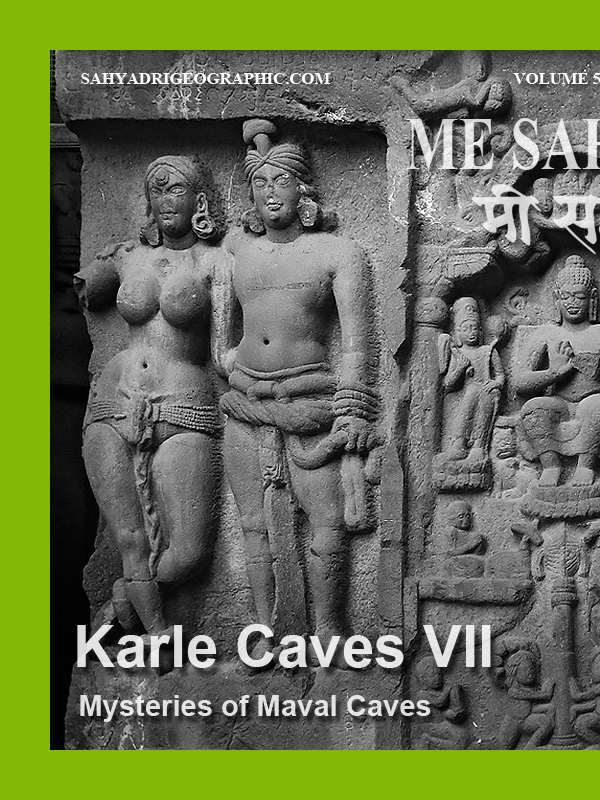 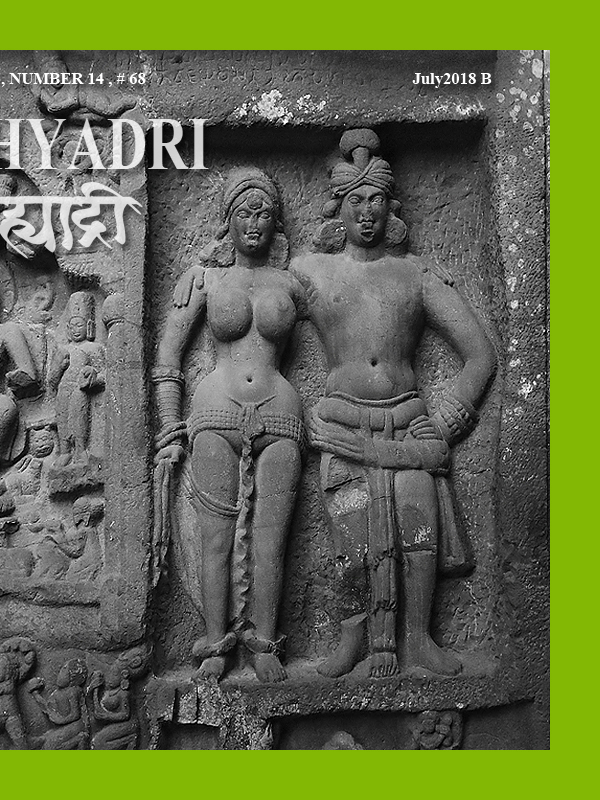
|
| |
| Me Sahyadri – July 2018 - B
|
| |
|
|
| |
  |
| The banner has been published here to improve the awareness of the trekkers and tourists visiting the various mountain forts, mountains in south western ghats. Please avoid accidents, by following good outdoor ethics such as no swimming in cisterns at mountain forts, no rock climbing without proper technical equipment and expertise. Please do not adventure, trek with any group or individually without understanding the risks associated. The frequency of the solo trekker fatalities have increased recently. Please strictly avoid solo treks. Please also avoid treks to mountains in large commercial groups, as it leads to damage to biodiversity of these high elevation ecological islands. Please respect the wildlife and biodiversity of the region. This has become more important as the ever increasing human interference is leading to severe damage to fragile ecosystems. Please be aware of the wildlife and biodiversity of the mountains before visiting these mountains. Please follow outdoor ethics. Follow ASI and Forest department rules. The concept of use of symbols for outdoor ethics was conceived and designed by "Sahyadri Trekker Bloggers Group". |
| |
|
|
| |
 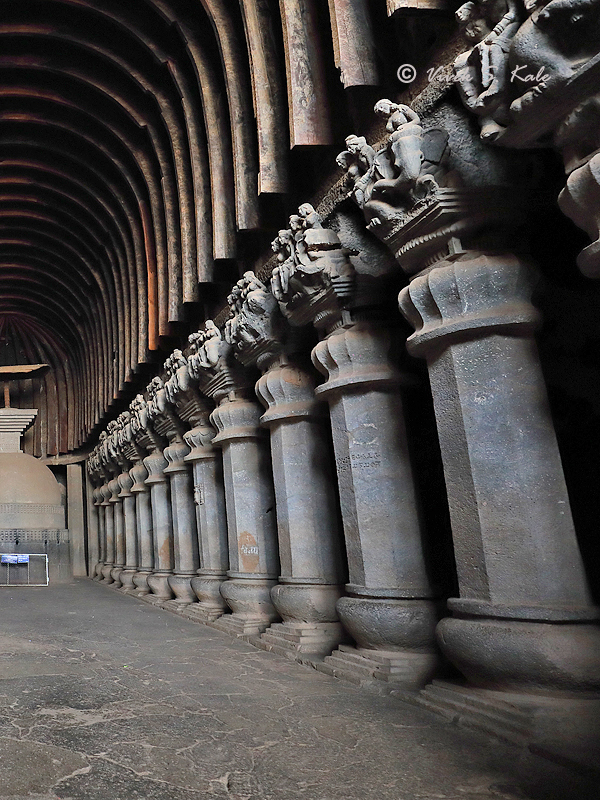 |
| |
| 1. Chaityagriha, Karle Caves, Maval Tehsil, Pune district, Maharashtra, India |
| |
|
|
कार्ले येथील चैत्यगृह भारतातील सर्वात भव्य व अप्रतिम चैत्यगृह आहे. चैत्यगृहाची लांबी दरवाजापासुन मागच्या भिंतीपर्यंत ३७.८ मीटर आहे. चैत्यगृहाची रुंदी १३.८ मीटर आहे. चैत्यगृहाची उंची १४ मीटर आहे. छत अर्धवर्तुळाकार आकाराचे आहे. चैत्यगृह खांबांमुळे दोन भागात विभागलेले आहे. खांबांच्या मागचा भाग आणि खांबांसमोरचा मुख्य भाग असे दोन भाग आहेत. डावीकडची आणि उजवीकडची खांबाची रांग स्तुपाच्या मागे अर्धवर्तुळात एकमेकांना मिळते.
चैत्यगृहातले कोरलेले खांब अप्रतिम आहेत. खांबाच्या सर्वात खाली तीन चौकटी आहेत. चौकटींवर खांबांना अर्ध गोल माठासारखा आकार दिला आहे. त्याच्यावरचा खांब अष्ट्कोनी आहे. वरच्या भागात पाकळ्या असलेल्या कमळाचा आकार आहे. त्यावर असलेल्या चौकटींवर हत्ती, घोडे व इतर प्राण्यांवर आरुढ मानवी शिल्पे आहेत. खांबांच्या वर पुढे व मागे दोन्ही बाजुस मानवी शिल्पे आहेत. पुढच्या भागात हत्तीवर आरुढ शिल्पे आहेत, मागच्या बाजुस मानवी शिल्पे हत्ती, घोडे, आणि सेंटॉर/स्फिंक्स वर आरुढ आहेत. एकुण मिळुन ४१ खांब आहेत. दरवाज्याच्या जवळचे सज्जाच्या खालचे चार खांब अष्ट्कोनी नाहीत. इतर सर्व खांब अष्टकोनी आहेत. स्तुपाच्या जवळच्या सात अष्टकोनी खांबांवर शिल्पे नाहीत.
|
|
The chaityagriha at Karle is the largest of its type in the whole of India. The hall measures 37.87 m deep from door to back. It is 13.87 m wide and 14.02 m high. This chaitya consists of an apsidal hall with a front verandah. The apsidal means the semicircular recess roof. The hall is divided into a nave (central open space) and two aisles (passages) by two rows of pillars. The two rows of pillars meet behind the stupa in a semicircle forming the semicircular recess.
The pillars are executed with the great ingenuity which reflect the sculptural art of the period. The pillars consist of a stepped base surmounted by a pot, octagonal shaft over it, the capital of inverted flower vase member, caged amalaka and an inverted stepped pyramid. Above this inverted stepped pyramid there are sculptures of animals with human riders, facing both aisle and main hall. The animals on the capital consist of elephants, horses and centaurs/sphinx like mythological animals. Centaurs are greek mythological animals with human face on horse body. There are total 41 pillars in Chaitya griha. The four pillars parallel to front wall near the entrance are non octagonal and support the beam. There are seven pillars around Stupa which are octagonal but without sculptures atop.
|
|
|
| |
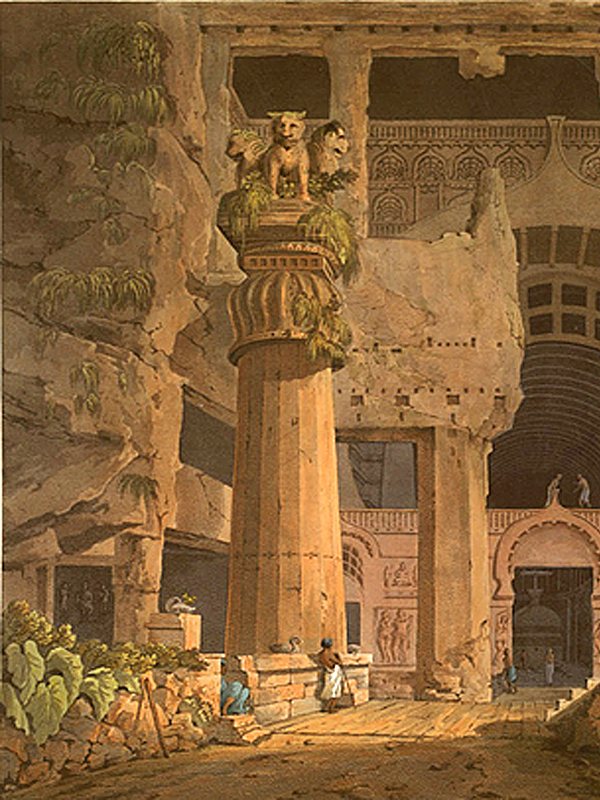 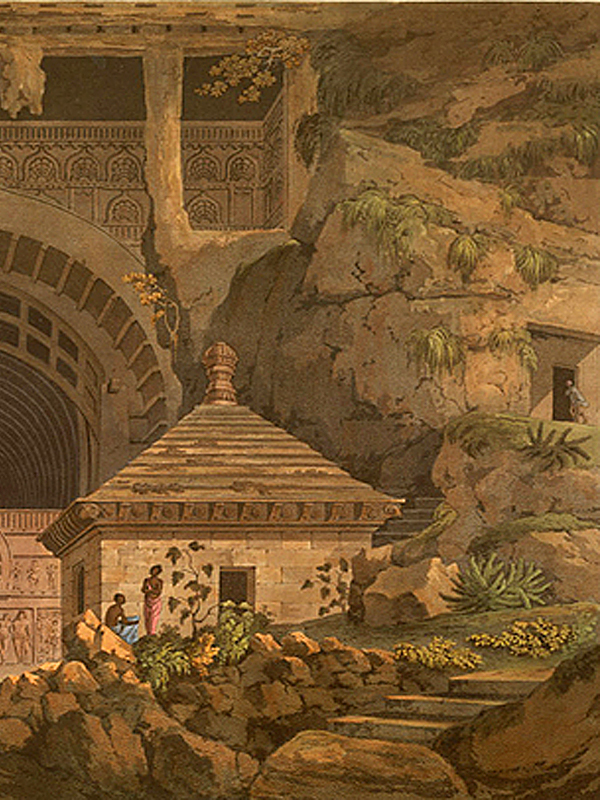 |
| |
| 2. Painting of Chaityagriha, Karle Caves, Maval Tehsil, Pune district, Maharashtra, India |
| |
|
|
| |
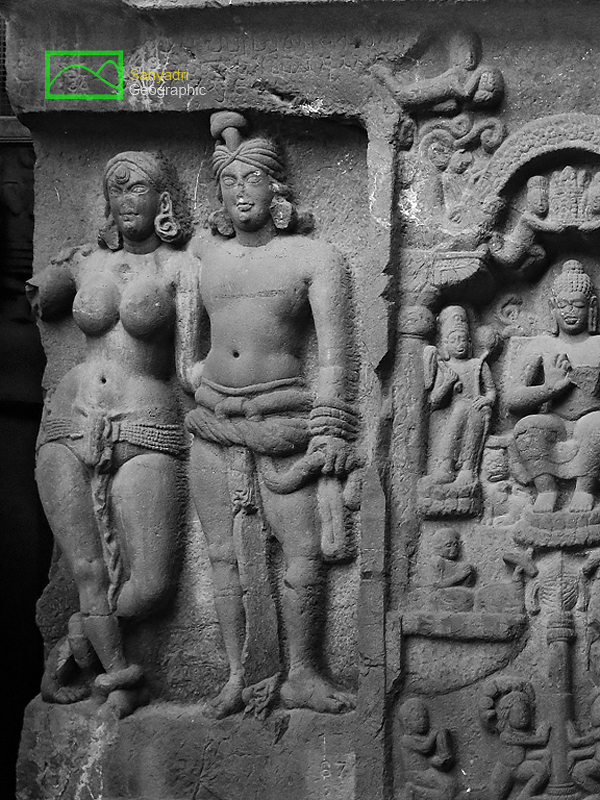 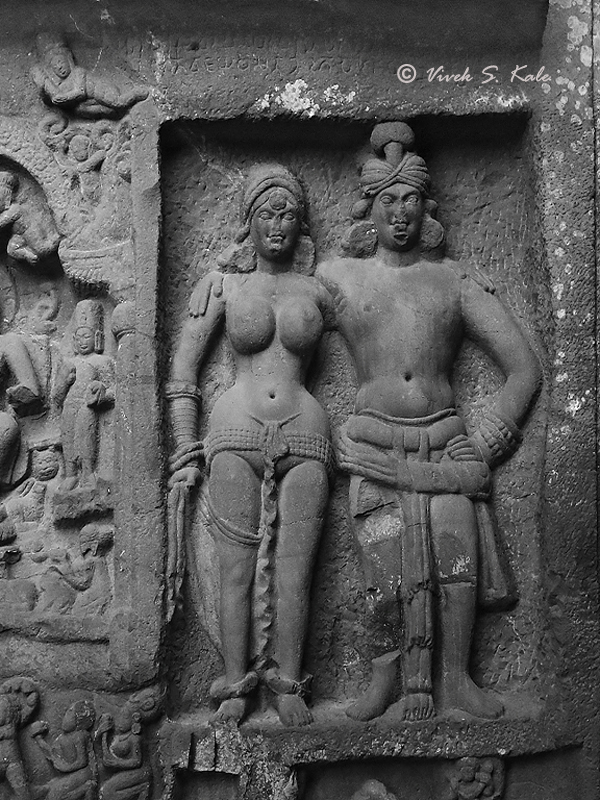 |
| |
| 3. Wall sculptures, Chaityagriha verandah (Right side), Karle Caves, Maval Tehsil, Pune district, Maharashtra, India |
| |
|
|
कार्ले चैत्यगृहाच्या मुख्य अंतर्गृहाच्या बाहेर असलेल्या ओसरीत उजवीकडील (दक्षिणेकडील) भागात भिंतींवर सुंदर शिल्प कोरली आहेत. उजवीकडील बाजूच्या मुख्य भिंतीवर असलेली शिल्प छायाचित्रात दाखविली आहेत. या भिंतीवर हीनयान काळात कोरलेल्या स्त्री पुरुष मिथुन जोड्या आहेत. तर नंतर च्या महायान काळात कोरलेली भगवान गौतम बुद्ध आणि बोधिसत्वांची शिल्प पहावयास मिळतात. भगवान गौतम बुद्धाचे चे सुंदर शिल्प या भिंतीवर पाहावयास मिळते. लहान मोठी भगवान गौतम बुद्ध आणि बोधिसत्वांची शिल्प, वरच्या भागात पहावयास मिळतात. येथे महत्वाचे शिलालेख सुद्धा आहेत.
|
|
At Karle Chaityagriha, on right (south) side of the verandah just before the entrance to main Chaityagriha hall, there are sculptures carved in the front wall. The sculptures between the two doors on right side are shown in the photograph. The Mithuna sculptures in which a pair of man and woman is shown are sculptures in original plan. However the central sculpture in which there is Gautam Buddha sculpture, is likely a later work during Mahayana period. There are few Buddha and Bodhisatva figures carved in small niches around.
|
|
|
| |
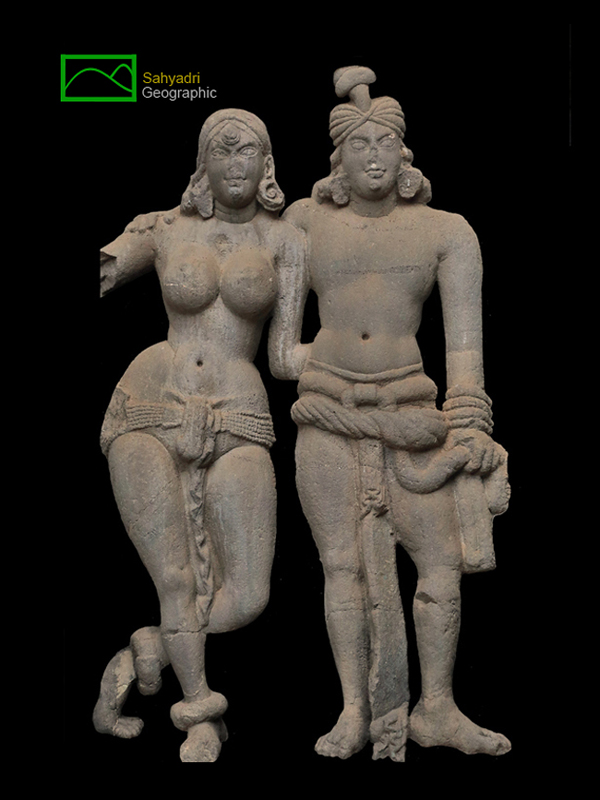 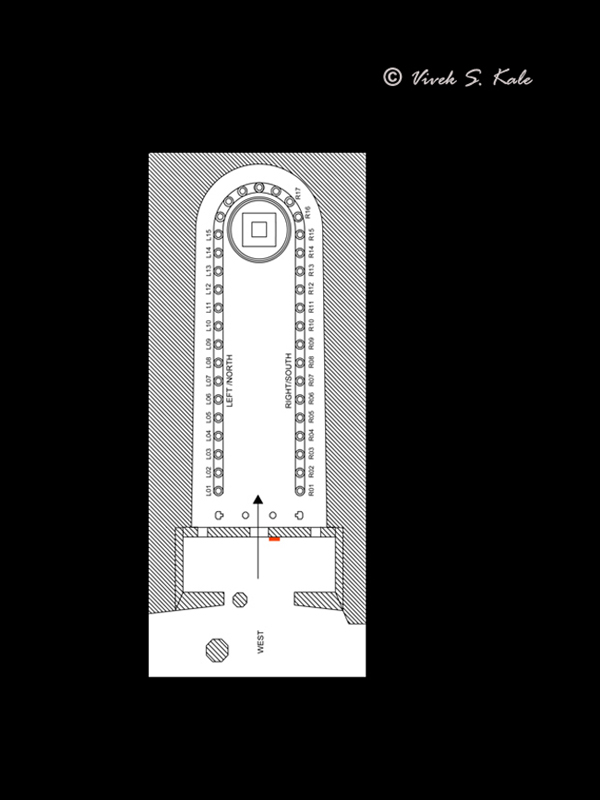 |
| |
| 4. Mithuna sculptures, Chaityagriha verandah, Karle Caves, Maval Tehsil, Pune district, Maharashtra, India |
| |
|
|
चैत्यगृहाच्या ओसरीत, चैत्यगृहात प्रवेश करण्यासाठी तीन दरवाजे आहेत. यातील मुख्य दरवाजाच्या लगत उजवीकडील शिल्पात मिथुन जोडी, (पुरूष व स्त्रीची एक जोडी) कोरली आहे. पुरूष व स्त्री शिल्पात शरीरावर पारंपारिक कपडे आहेत. पुरुषाच्या पागोट्याला मध्यभागी तुरा आहे. स्त्रीने माथ्यावर दागदागिने (टिका), मोठी कर्णभुषणे, कंबरपट्टा आणि पायात मोठे वाळे परिधान केले आहेत. पुरुषाने हातात कडी आणि मण्यांच्या माळा, परिधान केल्या आहेत. पुरुषाने कापडी कंबर पट्टा परिधान केला आहे. पुरुषाचे केस लांब आहे. स्त्रीचा उजवा हात तुटलेला आहे. आणि डावा हात पुरुषाच्या पाठीवर आहे. पुरुषाचा उजवा हात स्त्रीच्या खांद्यावर ठेवलेला आहे तर त्याच्या डाव्या हातात धोतराचे एक टोक आहे.
|
|
In this sculptures on the south side of the main door of the chaityagriha Mithuna pair, a standing pair of man and woman is carved. One can see elements of the dress on the body of both man and woman sculpture. The man has interesting headgear, with circular rounded bands around the central projection in headgear. The female has the cloth over her head. The ornaments such as forehead jewelry, large earrings, waist ornamented belt and large leg bracelets with four windings can be seen on a woman. The man has intricate headgear with wrist bracelets, beaded bracelets. The man is also wearing some kind of a waist belt made of flexible cloth or material. The man has long hair. The woman has her right hand broken and her left hand is around the back of the man. The right hand of man is resting on the shoulder of the woman while in his right hand he is holding the loose end of his lower body clothes.
|
|
|
| |
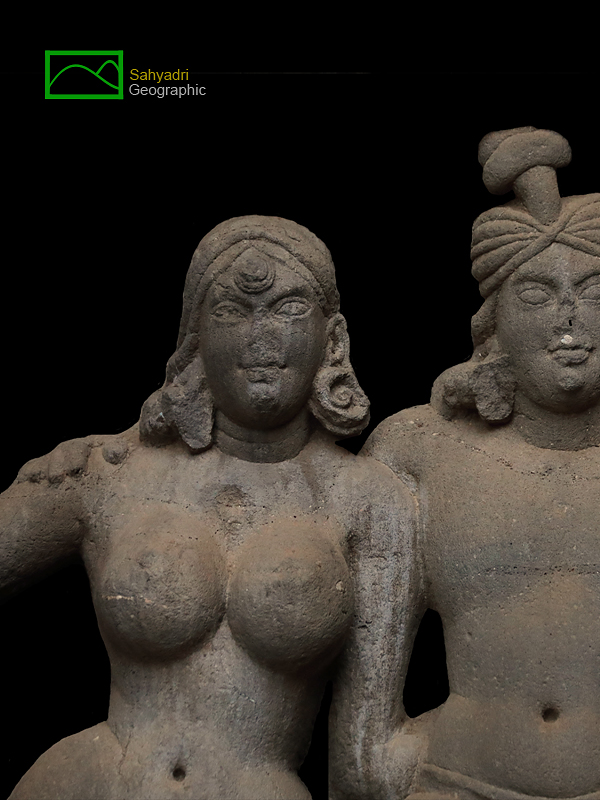 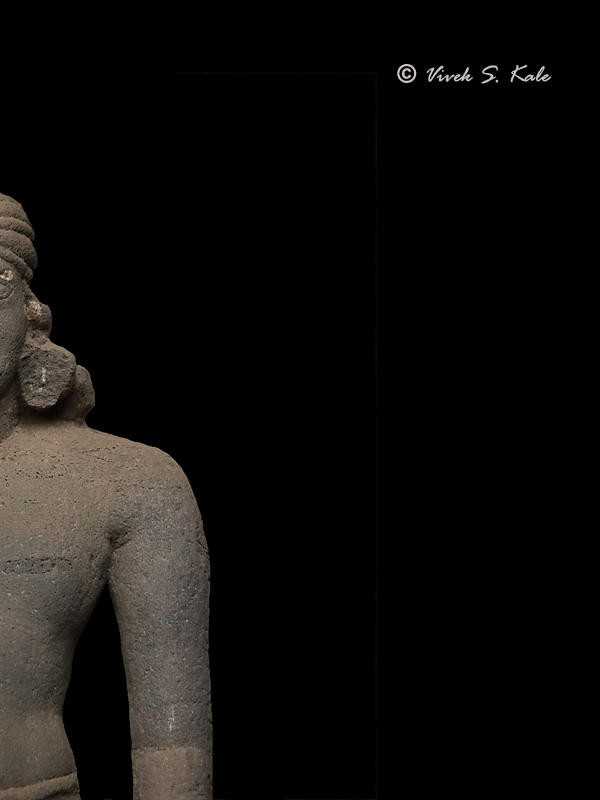 |
| |
| 5. Mithuna sculptures, Chaityagriha verandah, Karle Caves, Maval Tehsil, Pune district, Maharashtra, India |
| |
|
|
| |
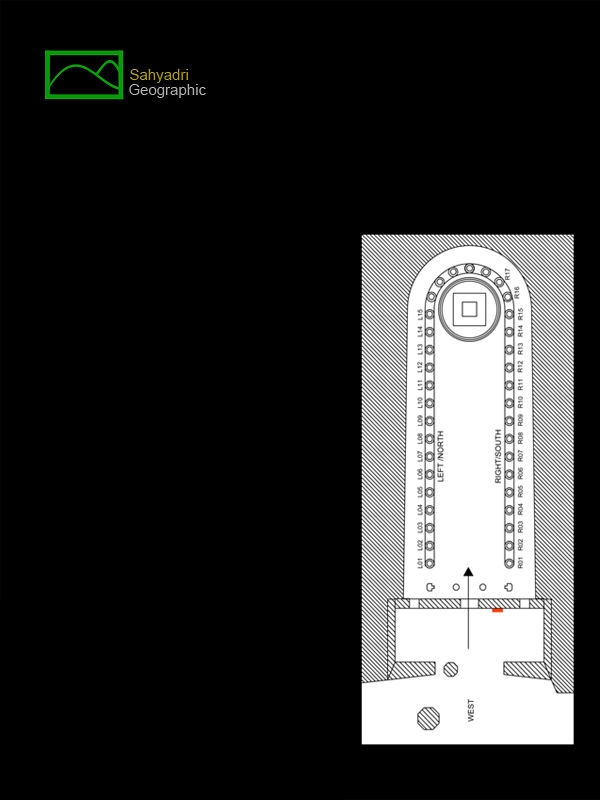 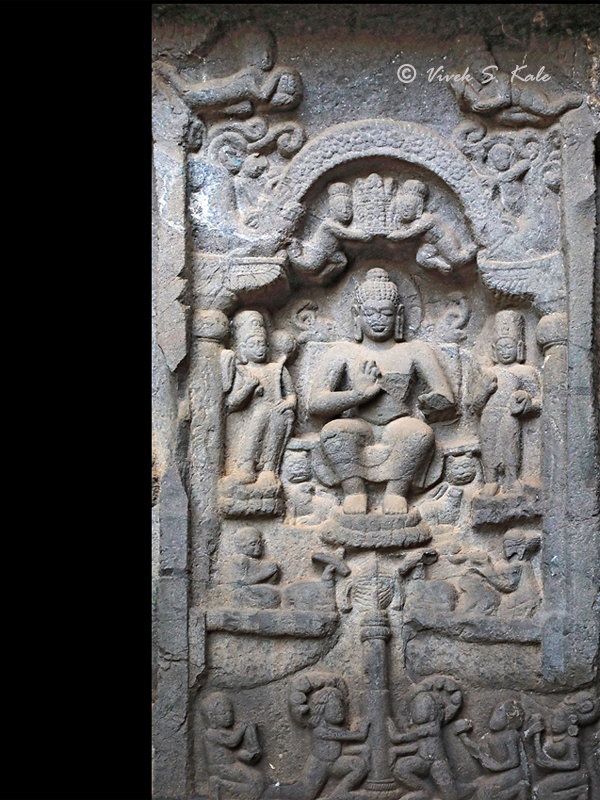 |
| |
| 6. Gautam Buddha Panel, Chaityagriha verandah, Karle Caves, Maval Tehsil, Pune district, Maharashtra, India |
| |
|
|
धर्मचक्र मुद्रा म्हणजे गौतम बुद्ध आपल्या अनुयायांना उपदेश करतानाची मुद्रा होय. येथे जणु गौतम बुद्ध धर्माचे चक्र फिरवत आहेत. गौतम बुद्ध यांनी त्यांचा पहिला उपदेश सारनाथ येथील हिरण उद्यानात दिला. चार धर्म सत्य आणि आठ मार्ग, आध्यात्माचा मध्य मार्ग याबद्दल उपदेश दिला. कुकर्म , कुबुद्धी आणि कुविचार यांचा त्याग महत्वाचा आहे. सकारात्मक विचारांतुन चार धर्म सत्य पद्धतीचा वापर करून अडचणींवर मात करत मोक्ष प्राप्ती असा हा उपदेश होय.
|
|
Dharmachakra is the pose of Buddha in Which he preaches his followers abot Dhamma. This mudra is called Dharmachakra or ‘the turning of the Wheel of Law’. It refers to one of the most important moments in the life of the Buddha when he gave his first sermon in the Deer Park at Sarnath. he teachings of the sermon include the Middle Way that avoids the extremes of pleasure and austerity, the Four Noble Truths, and the Eightfold Path. It is the Four Noble Truths that this sermon is specifically known for. The Turning of the Wheel of Dharma is mostly concerned with abandoning negative actions of the body, speech, and mind. The Four Noble Truths refer to movements that are produced in the mind, which will guide those who encounter them to liberation and enlightenment.
|
|
|
| |
 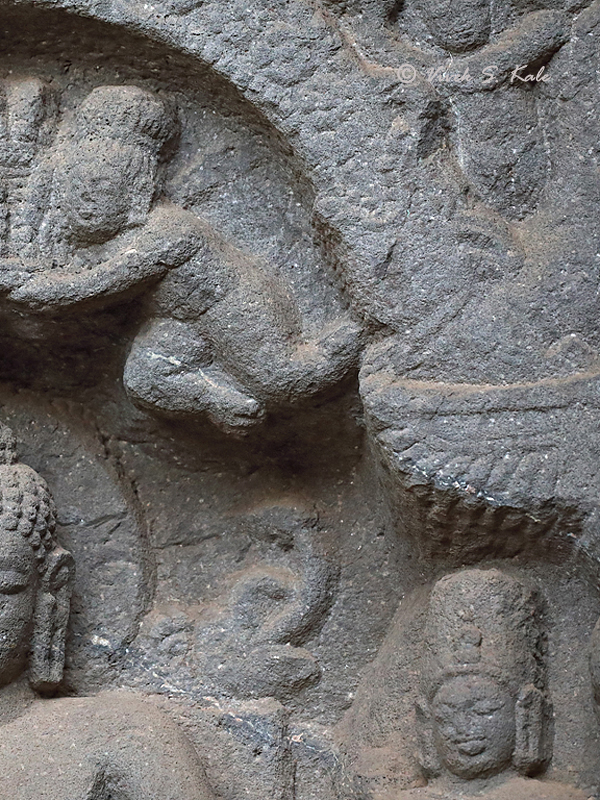 |
| |
| 7. Gautam Buddha Panel, Chaityagriha verandah (Right side) Karle Caves, Maval Tehsil, Pune district, Maharashtra, India
|
| |
|
|
| |
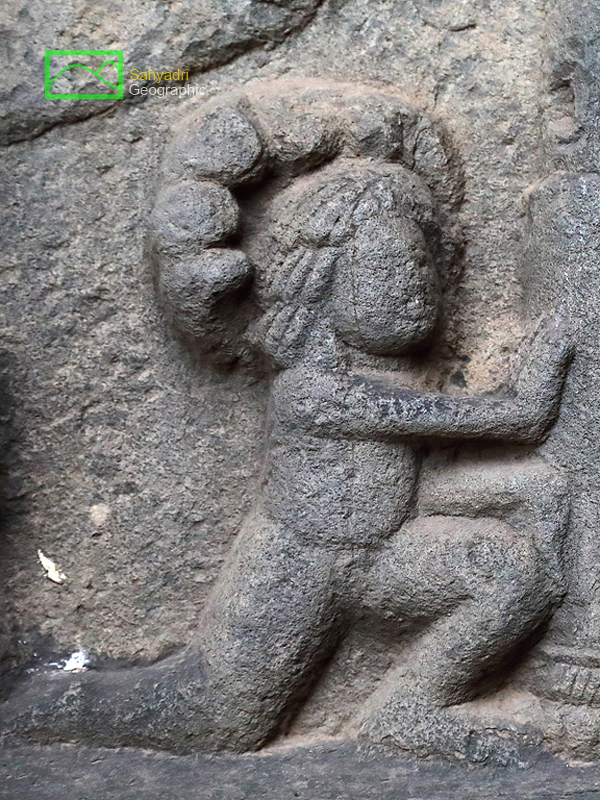  |
| |
| 8. Gautam Buddha Panel, Chaityagriha verandah, Karle Caves, Maval Tehsil, Pune district, Maharashtra, India |
| |
|
|
| |
 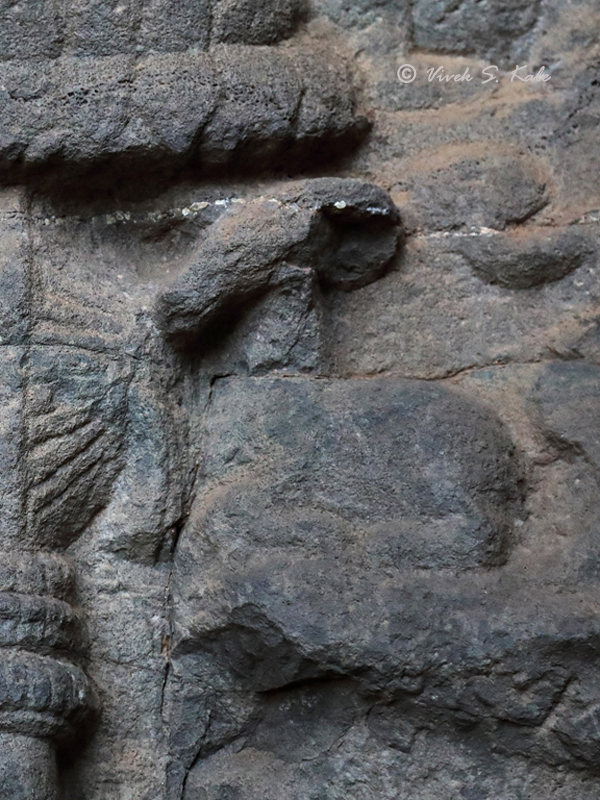 |
| |
| 9. Gautam Buddha Panel, Chaityagriha verandah, Karle Caves, Maval Tehsil, Pune district, Maharashtra, India |
| |
|
|
| |
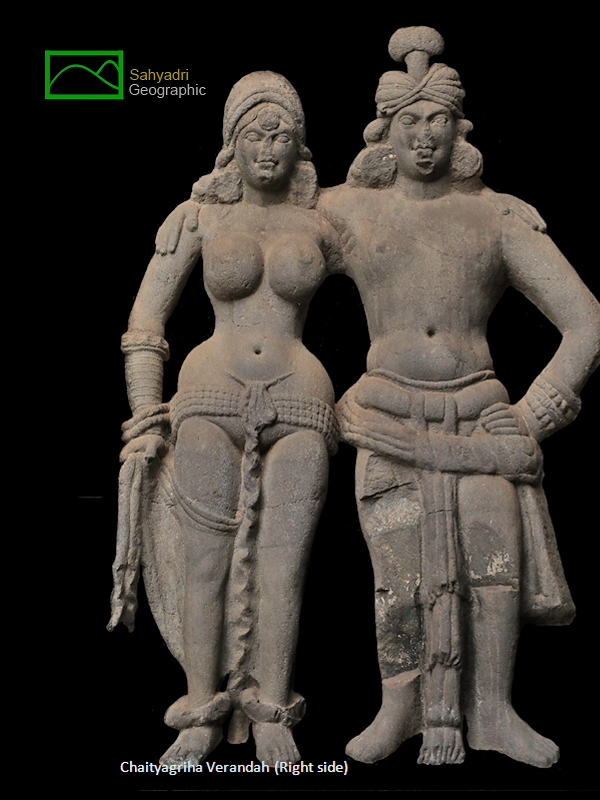 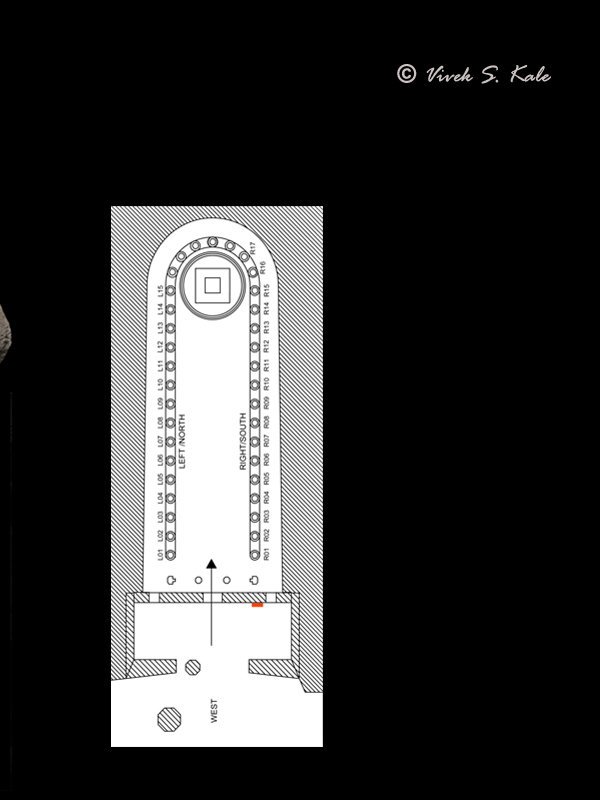 |
| |
| 10. Mithuna pair, Chaityagriha verandah, Karle Caves, Maval Tehsil, Pune district, Maharashtra, India |
| |
|
|
चैत्यगृहाच्या ओसरीत, चैत्यगृहात प्रवेश करण्यासाठी तीन दरवाजे आहेत. यातील उजवीकडील दरवाजाच्या लगत डावीकडील शिल्पात मिथुन जोडी, (पुरूष व स्त्रीची एक जोडी) कोरली आहे. पुरूष व स्त्री शिल्पात शरीरावर पारंपारिक कपडे आहेत. पुरुषाच्या पागोट्याला मध्यभागी तुरा आहे. स्त्रीने माथ्यावर दागदागिने (टिका), कंबरपट्टा, हातात बांगडया, मण्यांच्या माळा आणि पायात मोठे वाळे परिधान केले आहेत. पुरुषाने हातात कडे परिधान केले आहेत. पुरुषाने कापडी कंबर पट्टा परिधान केला आहे. पुरुषाचे केस लांब आहे. स्त्रीच्या तिने आपल्या वस्त्राचे टोक उजव्या हातात धरले आहे. आणि डावा हात पुरुषाच्या खांद्यावर आहे. पुरुषाचा उजवा हात स्त्रीच्या खांद्यावर ठेवलेला आहे तर त्याचा डावा हात त्याच्या स्वतःच्या कंबरेवर ठेवलेला आहे.
|
|
In this sculpture on the north (left) side of the south (right) side door of the chaityagriha, Mithuna pair, a standing pair of man and woman is carved. One can see elements of the dress on the body of both man and woman sculpture. The man has interesting headgear, with the central projection in headgear. The woman has the cloth over her head. The ornaments such as forehead jewelry, several wrist ring bracelets, waist ornamented belt, and large leg bracelets can be seen on the woman. The man has intricate head gear, and wrist bracelets. The man is also wearing some kind of a waist belt made of flexible cloth or material. The man has long hair. The woman is holding her garment end in her right hand and her left hand is resting on man’s shoulder. The right hand of man is resting over the shoulder of the woman while his left hand is resting on his waist.
|
|
|
| |
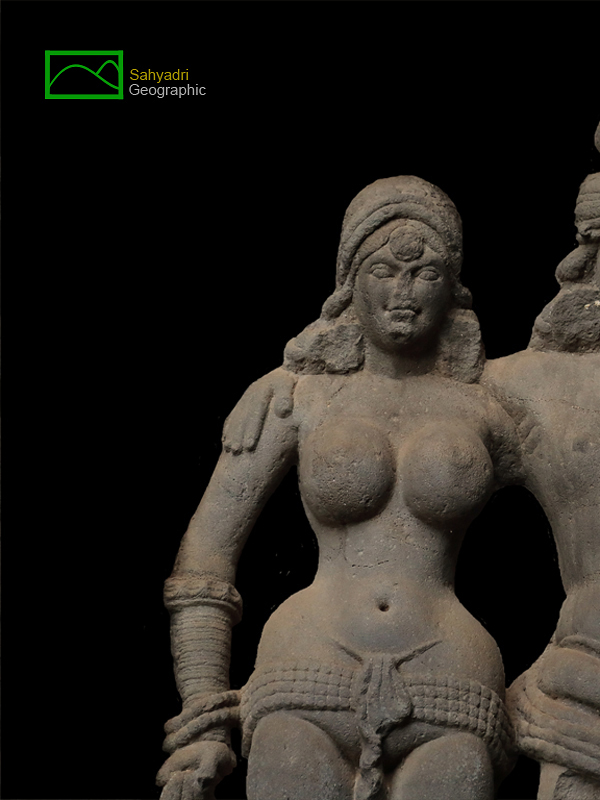 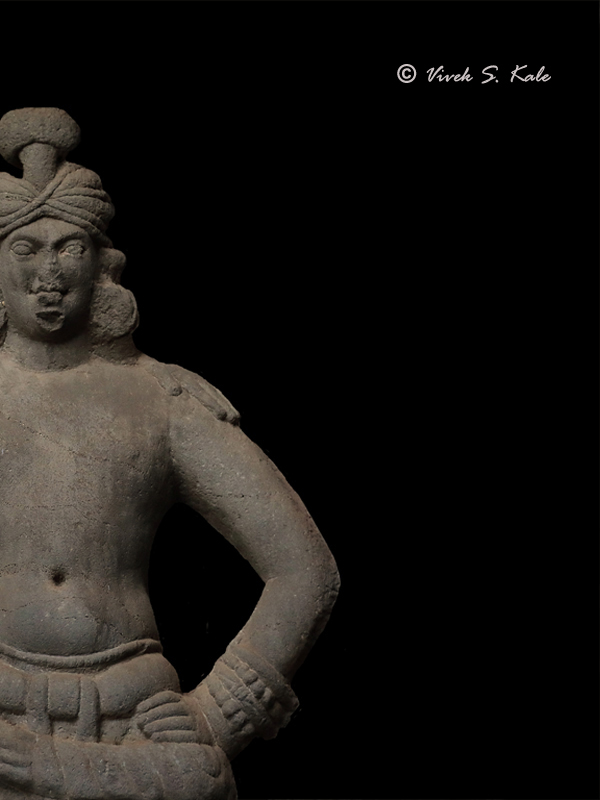 |
| |
| 11. Mithuna pair, Chaityagriha verandah, Karle Caves, Maval Tehsil, Pune district, Maharashtra, India |
| |
|
|
| |
 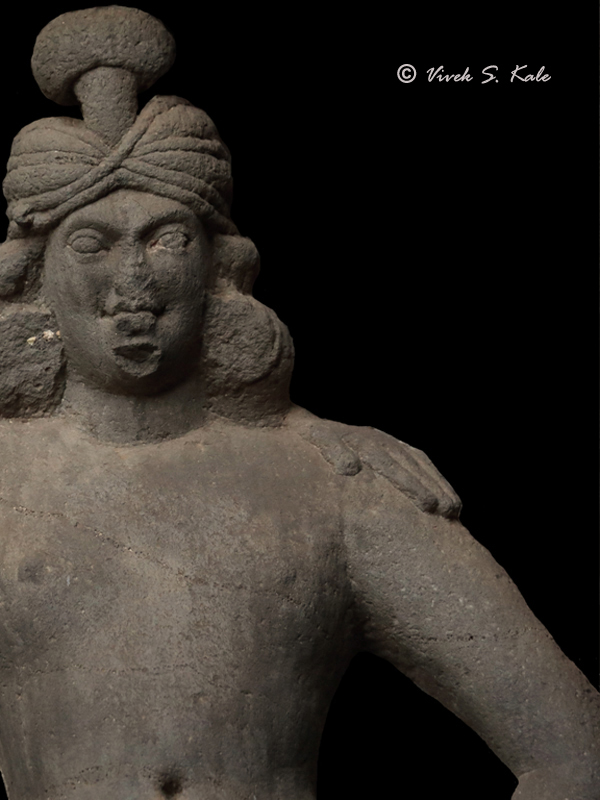 |
| |
| 12. Mithuna pair, Chaityagriha verandah, Karle Caves, Maval Tehsil, Pune district, Maharashtra, India |
| |
|
|
| |
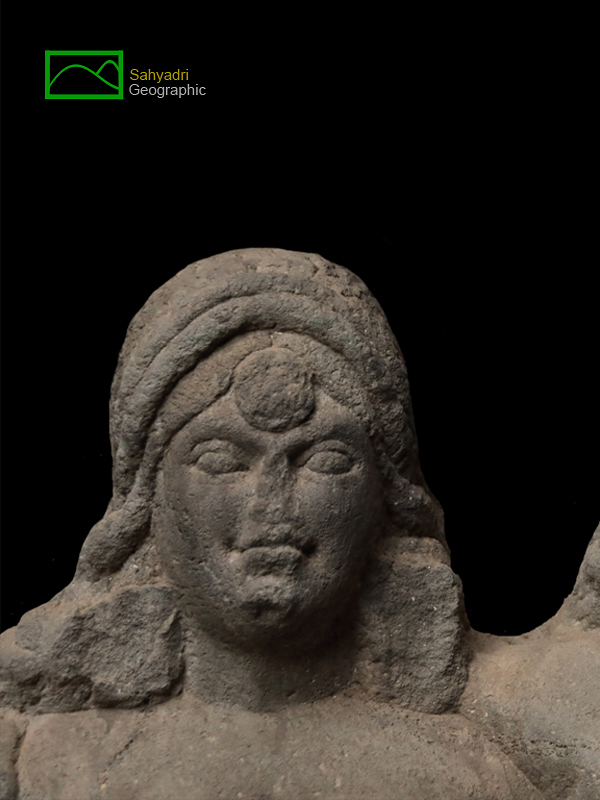 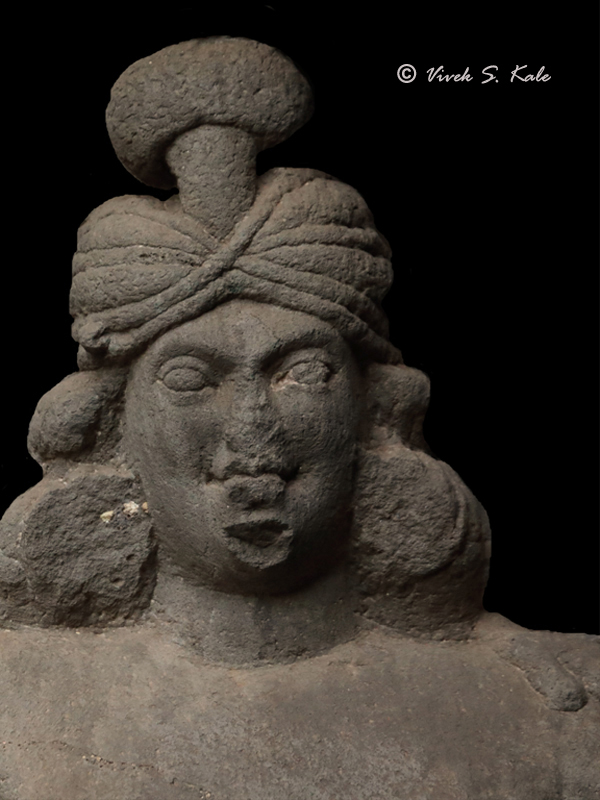 |
| |
| 13. Mithuna sculptures, Chaityagriha verandah, Karle Caves, Maval Tehsil, Pune district, Maharashtra, India |
| |
|
|
| |
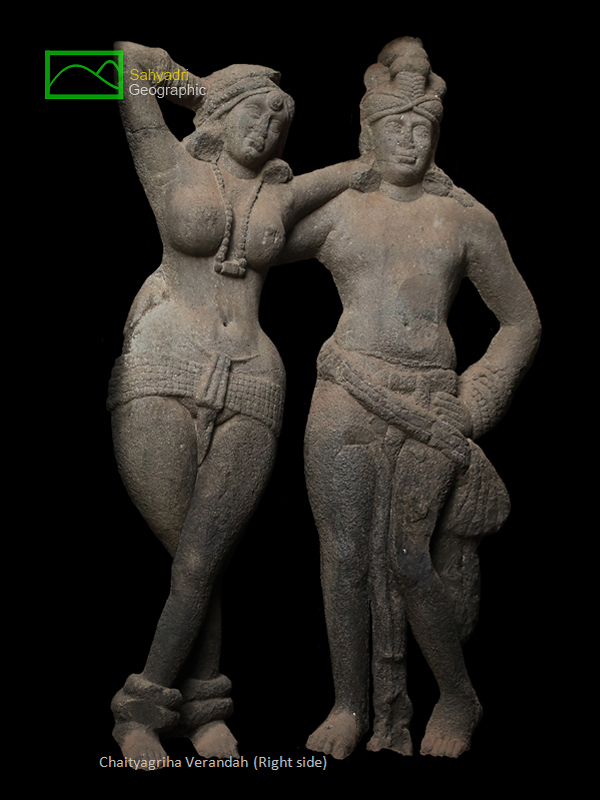 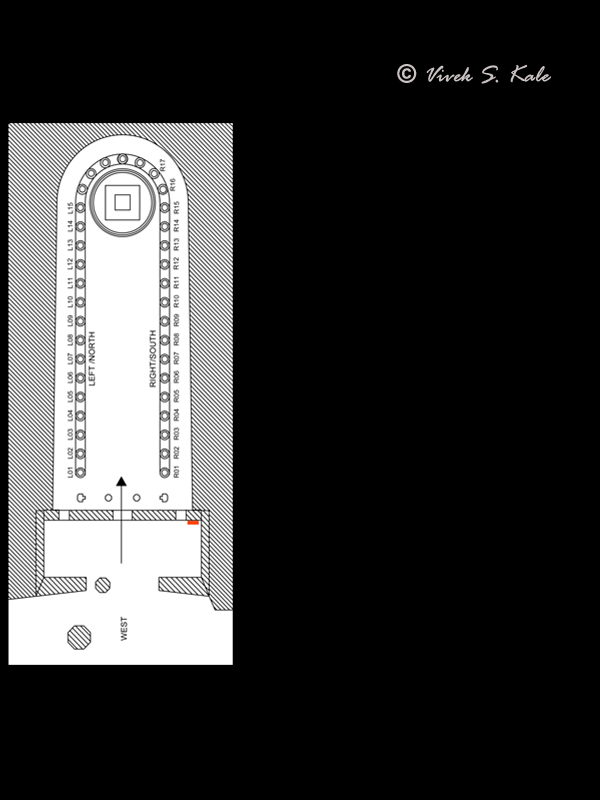 |
| |
| 14. Mithuna sculptures, Chaityagriha verandah, Karle Caves, Maval Tehsil, Pune district, Maharashtra, India |
| |
|
|
चैत्यगृहाच्या ओसरीत, चैत्यगृहात प्रवेश करण्यासाठी तीन दरवाजे आहेत. यातील उजवीकडील दरवाजाच्या लगत उजवीकडील शिल्पात मिथुन जोडी, (पुरूष व स्त्रीची एक जोडी) कोरली आहे. पुरूष व स्त्री शिल्पात शरीरावर पारंपारिक कपडे आहेत. पुरुषाच्या पागोट्याला मध्यभागी तुरा आहे. स्त्रीने माथ्यावर दागदागिने (टिका), मोठी कर्णभुषणे, कंबरपट्टा, गळ्यात हार, हातात बांगडया, मण्यांच्या माळा आणि पायात मोठे वाळे परिधान केले आहेत. पुरुषाने हातात कडी आणि मण्यांच्या माळा, परिधान केल्या आहेत. पुरुषाने कापडी कंबर पट्टा परिधान केला आहे. पुरुषाचे केस लांब आहे. स्त्रीचा उजवा हात तिच्या डोक्यावर ठेवलेला आहे. आणि डावा हात पुरुषाच्या खांद्यावर आहे. पुरुषाचा उजवा हात स्त्रीच्या पाठीवर ठेवलेला आहे तर त्याचा डावा हात त्याच्या स्वतःच्या कंबरेवर ठेवलेला आहे.
. |
|
In this sculptures on the south (right) side of the south (right) side door of the chaityagriha, Mithuna pair, a standing pair of man and woman is carved. One can see elements of dress on body of both man and woman sculpture. The man has interesting headgear, with the central projection in headgear. The woman has cloth over her head. The ornaments such as forehead jewellery, several wrist ring bracelets, waist ornamented belt, large beaded necklace, and large leg bracelets can be seen on woman. The man has intricate head gear, and wrist bracelets, with beaded wrist bracelets. The man is also wearing some kind of a waist belt made of flexible cloth or material. The man has long hair. The woman has her right hand resting on her own head and her left hand is resting on man’s shoulder. The man has his right hand resting on woman’s back and his left hand is resting on his own waist.
|
|
|
| |
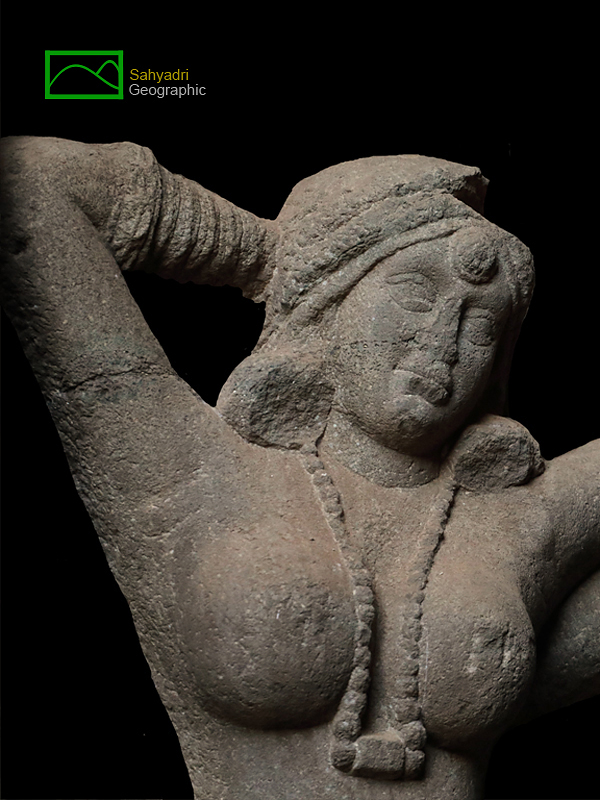  |
| |
| 15. Mithuna sculptures, Chaityagriha verandah, Karle Caves, Maval Tehsil, Pune district, Maharashtra, India |
| |
|
|
| |
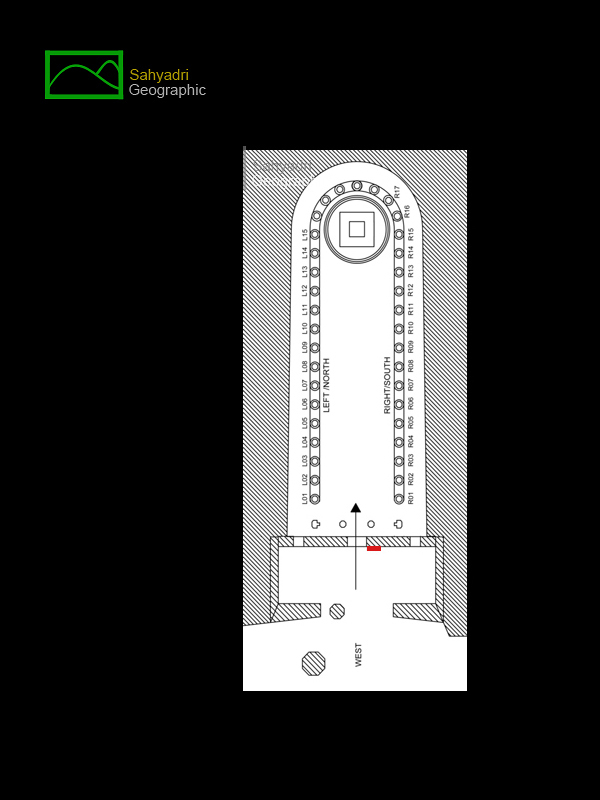  |
| |
| 16. Bhagwan Gautam Buddha sculpture, Chaityagriha verandah, Karle Caves, Maval Tehsil, Pune district, Maharashtra, India |
| |
|
|
धर्मचक्र मुद्रा म्हणजे गौतम बुद्ध आपल्या अनुयायांना उपदेश करतानाची मुद्रा होय. येथे जणु गौतम बुद्ध धर्माचे चक्र फिरवत आहेत. गौतम बुद्ध यांनी त्यांचा पहिला उपदेश सारनाथ येथील हिरण उद्यानात दिला. चार धर्म सत्य आणि आठ मार्ग, आध्यात्माचा मध्य मार्ग याबद्दल उपदेश दिला. कुकर्म , कुबुद्धी आणि कुविचार यांचा त्याग महत्वाचा आहे. सकारात्मक विचारांतुन चार धर्म सत्य पद्धतीचा वापर करून अडचणींवर मात करत मोक्ष प्राप्ती असा हा उपदेश होय.
|
|
Dharmachakra is the pose of Buddha in Which he preaches his followers abot Dhamma. This mudra is called Dharmachakra or ‘the turning of the Wheel of Law’. It refers to one of the most important moments in the life of the Buddha when he gave his first sermon in the Deer Park at Sarnath. he teachings of the sermon include the Middle Way that avoids the extremes of pleasure and austerity, the Four Noble Truths, and the Eightfold Path. It is the Four Noble Truths that this sermon is specifically known for. The Turning of the Wheel of Dharma is mostly concerned with abandoning negative actions of the body, speech, and mind. The Four Noble Truths refer to movements that are produced in the mind, which will guide those who encounter them to liberation and enlightenment.
|
|
|
| |
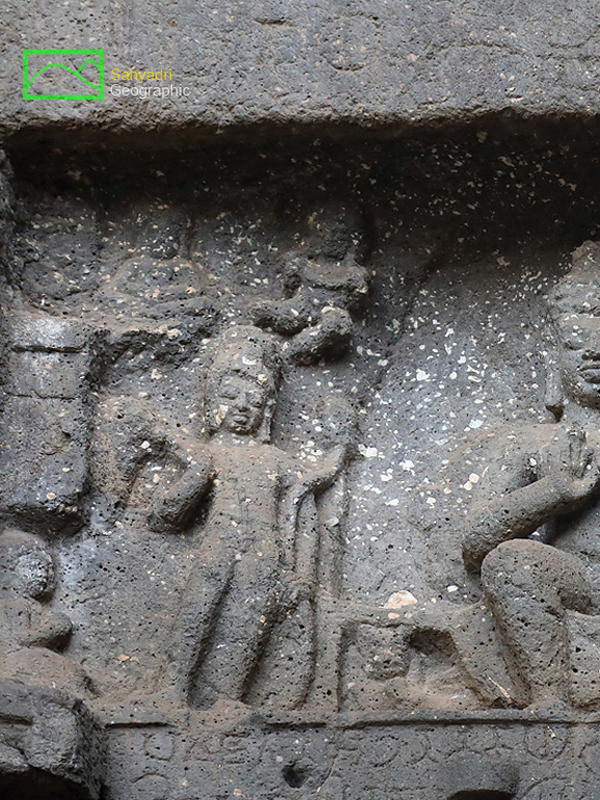 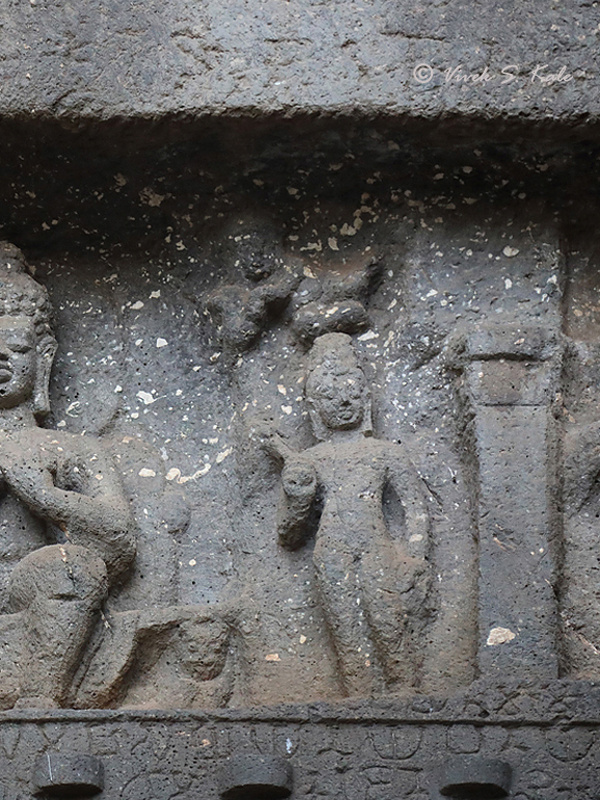 |
| |
| 17. Bhagwan Gautam Buddha sculpture, Chaityagriha verandah, Karle Caves, Maval Tehsil, Pune district, Maharashtra, India |
| |
|
|
| |
  |
| |
| 18. Bhagwan Gautam Buddha sculpture, Chaityagriha verandah, Karle Caves, Maval Tehsil, Pune district, Maharashtra, India |
| |
|
|
चैत्यगृहाच्या दालनात भगवान गौतम बुद्धांचे ध्यानस्थ मुद्रेत असलेले शिल्प आहे. भगवान गौतम बुद्धांच्या दोन बाजूस दोन उभे बोधिसत्व आहेत. धर्म आणि संघ याबद्दल ध्यान, एकाग्रता याचे प्रतीक म्हणजे ध्यानमुद्रा होय. तळवा वर केलेले, एकेमेकांवर ठेवलेले दोन हात मांडीवर वर ठेवले आहेत. उजवा हात डाव्या हातावर ठेवला आहे. हे शिल्प महायान काळात कोरले आहे.
|
|
The verandah of chaityagriha has a sculpture of seating haloed Buddha in meditation mudra or dhnyan mudra. Buddha is flanked with standing Bodhisatvas on either side. Dhnyanmudra signifies meditation, concentration of the good Law and the saṅgha. The two hands are placed on the lap, right hand on left with fingers fully stretched (four fingers resting on each other and the thumbs facing upwards towards one another), with palms facing upwards. This panel is Mahayana Buddhism sculpture made in Mahayana period.
|
|
|
| |
 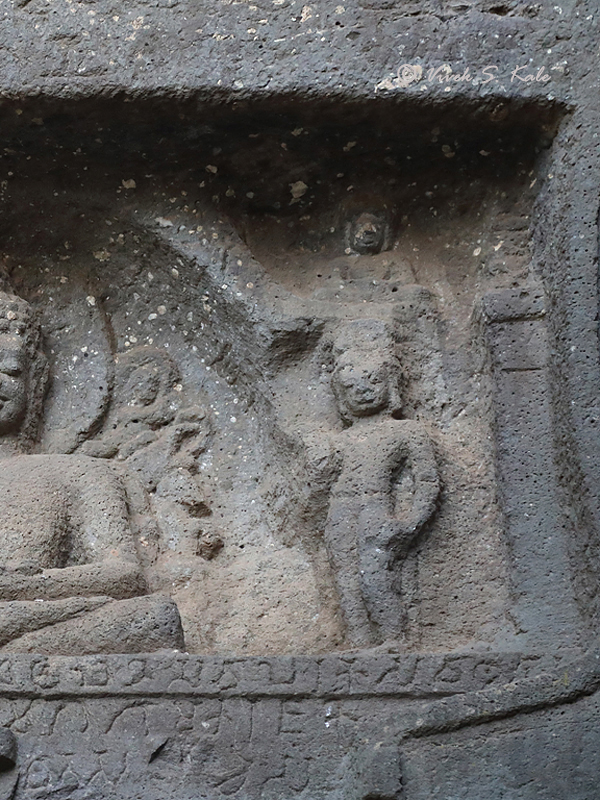 |
| |
| 19. Bhagwan Gautam Buddha sculpture, Chaityagriha verandah, Karle Caves, Maval Tehsil, Pune district, Maharashtra, India |
| |
|
|
| |
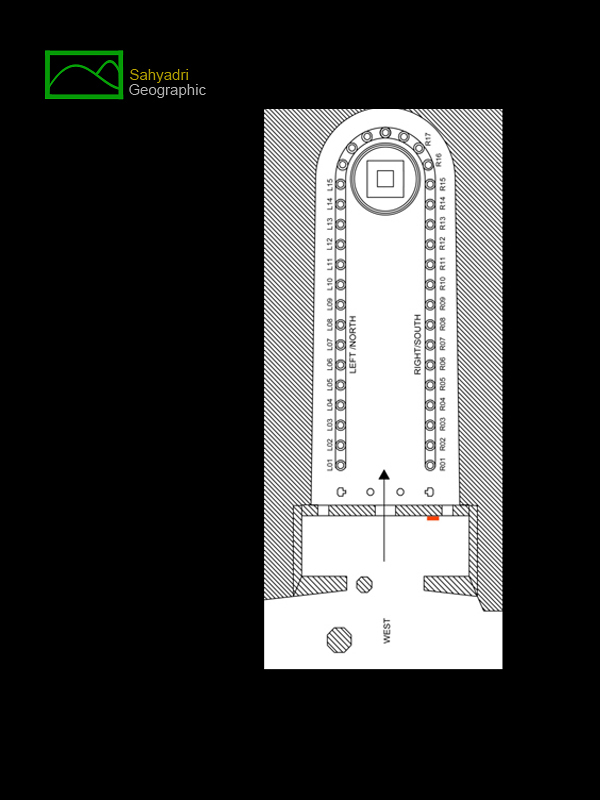  |
| |
| 20. Bhagwan Gautam Buddha sculpture, Chaityagriha verandah, Karle Caves, Maval Tehsil, Pune district, Maharashtra, India |
| |
|
|
धर्मचक्र मुद्रा म्हणजे गौतम बुद्ध आपल्या अनुयायांना उपदेश करतानाची मुद्रा होय. येथे जणु गौतम बुद्ध धर्माचे चक्र फिरवत आहेत. गौतम बुद्ध यांनी त्यांचा पहिला उपदेश सारनाथ येथील हिरण उद्यानात दिला. चार धर्म सत्य आणि आठ मार्ग, आध्यात्माचा मध्य मार्ग याबद्दल उपदेश दिला. कुकर्म , कुबुद्धी आणि कुविचार यांचा त्याग महत्वाचा आहे. सकारात्मक विचारांतुन चार धर्म सत्य पद्धतीचा वापर करून अडचणींवर मात करत मोक्ष प्राप्ती असा हा उपदेश होय.
|
|
Dharmachakra is the pose of Buddha in Which he preaches his followers abot Dhamma. This mudra is called Dharmachakra or ‘the turning of the Wheel of Law’. It refers to one of the most important moments in the life of the Buddha when he gave his first sermon in the Deer Park at Sarnath. he teachings of the sermon include the Middle Way that avoids the extremes of pleasure and austerity, the Four Noble Truths, and the Eightfold Path. It is the Four Noble Truths that this sermon is specifically known for. The Turning of the Wheel of Dharma is mostly concerned with abandoning negative actions of the body, speech, and mind. The Four Noble Truths refer to movements that are produced in the mind, which will guide those who encounter them to liberation and enlightenment.
|
|
|
| |
  |
| |
| 21. Bhagwan Gautam Buddha sculpture, Chaityagriha verandah, Karle Caves, Maval Tehsil, Pune district, Maharashtra, India |
| |
|
|
| |
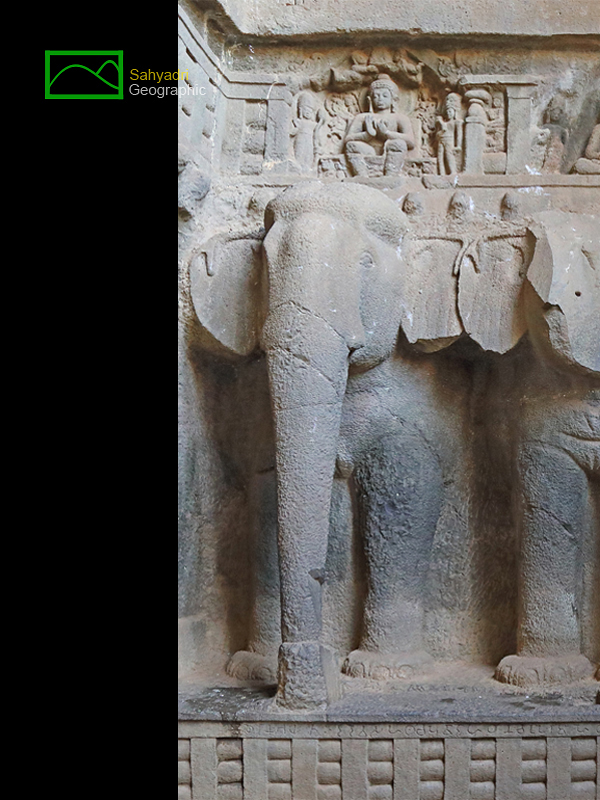 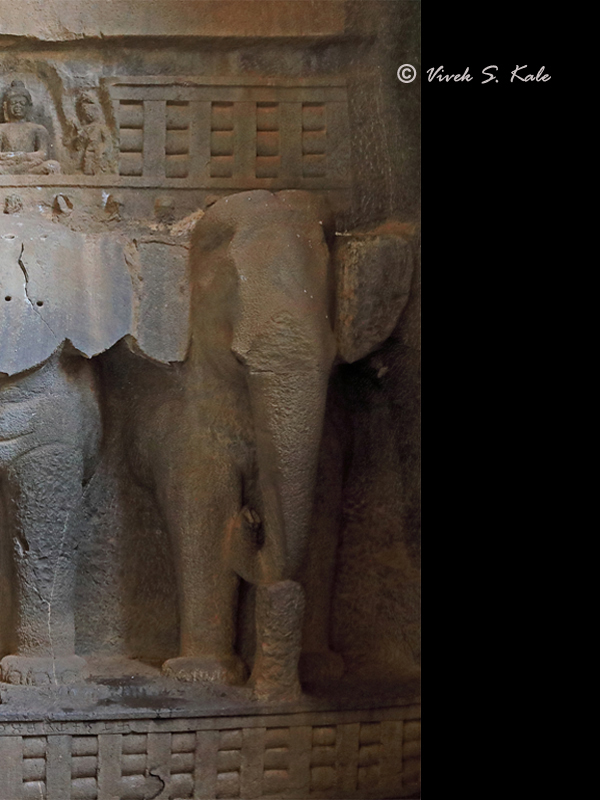 |
| |
| 22. Elephant sculptures, Chaityagriha verandah, Karle Caves, Maval Tehsil, Pune district, Maharashtra, India |
| |
|
|
चैत्यगृहाच्या दालनात डाव्या बाजुला, भिंतीवर सुंदर कोरीव काम केले आहे. सर्वात खाली पहिल्या पातळीत वेदिका कोरली आहे. यावर दुसऱ्या पातळीत तीन हत्तीचें दर्शनी भाग कोरले आहेत. हत्ती हीनयान काळात कोरलेले आहेत. हत्तीच्या वर हीनयान काळात वेदिका कोरली होती. नंतरच्या महायान काळात या वेदिकेवर महायान काळात प्रचलित परंपरेनुसार भगवान गौतम बुद्ध, बोधिसत्व यांची लहान शिल्प कोरली आहेत. वरच्या म्हणजे चौथ्या पातळी पासुन वर चार मजले असलेला प्रासाद कोरला आहे. यात स्त्री पुरुष मिथुन जोड्या, अर्ध दंडगोलाकार (जणू लाकडी) वेदिका, वेदिका, चैत्य गवाक्ष, दरवाजे कोरलेले आहेत. हे एखाद्या लाकडी प्रासादांची नक्कल असावी.
|
|
The verandah of chaityagriha has side walls on right and right sides. The right side wall is shown here. This wall has rail pattern at the bottom. Above the elevated platform there are three elephants with their front sculptured out of the walls. The elephants are clearly part of the original Hinayana design of this wall. Above the wall there are traces of oroginal rail patterned surface, which have been worked over with Mahayana Buddha sculptures on top of three elephants. Above there Buddha sculptures there are various levels of Chaitya window ornamentation with chaitya windows, Mithuna couples in dancing poses, rail patterns, cornice patterns.
|
|
|
| |
  |
| |
| 23. Gautam Buddha sculpture, Chaityagriha, Karle Caves, Maval Tehsil, Pune district, Maharashtra, India |
| |
|
|
चैत्यगृहाच्या दालनात भगवान गौतम बुद्धांची ध्यानस्थ आणि धर्मचक्र मुद्रेत असलेली शिल्प आहेत. भगवान गौतम बुद्धांच्या दोन बाजूस दोन उभे बोधिसत्व आहेत. शिल्प महायान काळात कोरलेली आहेत. वरच्या भागात भगवान गौतम बुद्धाची लहान शिल्प आहेत. हीनयांन काळात भगवान गौतम बुद्धाची शिल्प कोरण्याची परंपरा नव्हती. हीनयांन काळात मुख्यतः स्तूप, धर्मचक्र व इतर चिन्हाची पूजा केली जात होती. महायान काळात भगवान गौतम बुद्धाची शिल्प कोरण्याची परंपरा सुरु झाली. हत्तीच्या शिल्पावर पूर्वी वेदिका पट्टी कोरली होती. या ठिकाणी नंतर च्या काळात (महायान काळात) भगवान गौतम बुद्धाची शिल्प कोरण्यात आली. हत्ती वेगळया काळात आणि भगवान गौतम बुद्धाची शिल्प वेगळ्या काळात कोरण्यात आली. येथे दिसणारी भगवान गौतम बुद्धाची शिल्प एक सारखी आहेत. एवढी एकसारखी शिल्प एकाच ठिकाणी असण्यामागे कारण काय असावे ? अशी शिल्प पुण्य प्राप्तीसाठी मठाला दान देताना विविध देणगीदारांनी कोरुन घेतली असावीत.
|
|
Seating Buddha - Seating Buddha in Dhnyan mudra or in dharmachakra mudra is flanked by standing Bodhisatvas. There are smaller images of Buddha at top. During Hinayana period it was not a practice to create Buddha scultures. Instead they used to create Stupa and other sysmbols in the Chaityagriha. During Mahayana period, the practice of creating Buddha sculptures started. Here the original Hinayana design of this Chityagriha pravesh Dalan (Verandha) was such that there was a rail pattern above the elephant sculptures. Later during Mahayana period the Buddha sculptures were made where the rail patterns were carved. Though the Buddha sculpture looks like he is seating on the top of the elephant, that was not a original plan. These type of repeatative sculptures of the same design, on the walls suggest that such sculptures were made by the visitors, to earn the “Punya”, and donations. So for various visitors there are various such repeatative sculptures.
|
|
|
| |
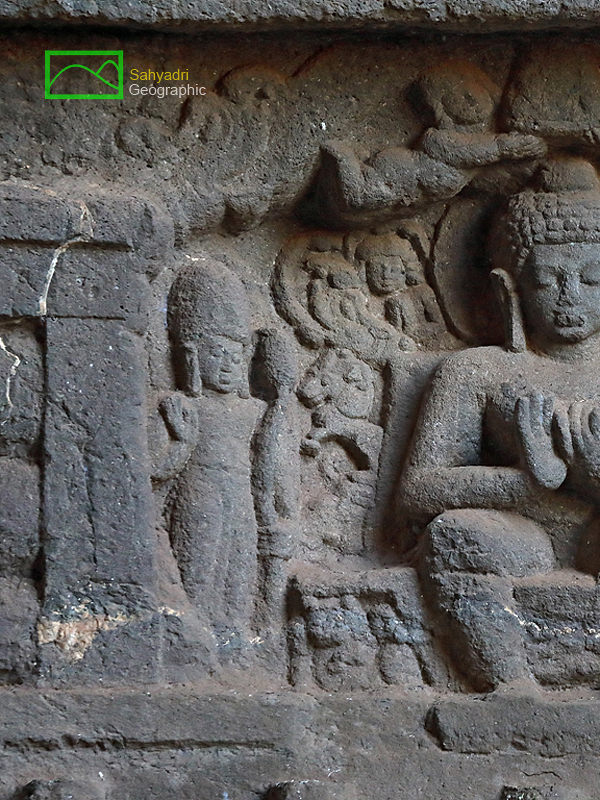 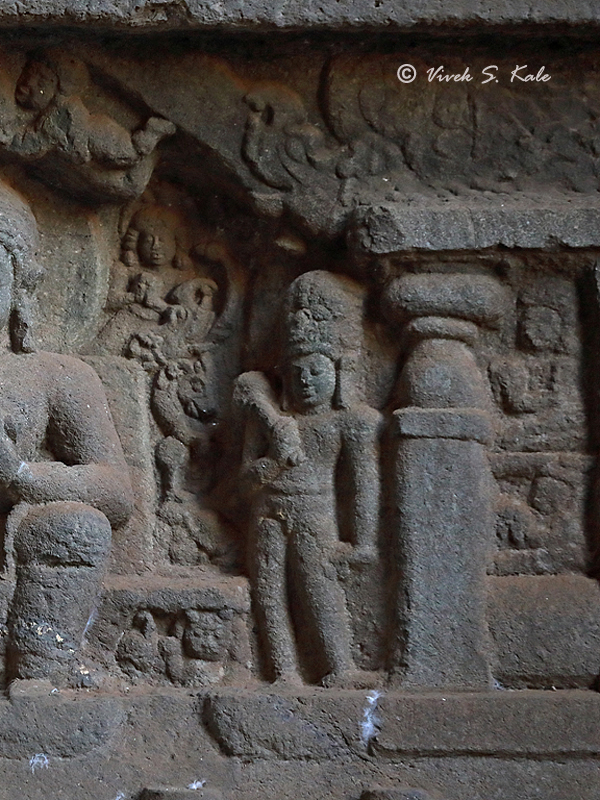 |
| |
| 24. Gautam Buddha sculpture, Chaityagriha verandah,Karle Caves, Maval Tehsil, Pune district, Maharashtra, India |
| |
|
|
| |
  |
| |
| 25. Mithuna sculptures, Chaityagriha verandah, Karle Caves, Maval Tehsil, Pune district, Maharashtra, India |
| |
|
|
हत्ती च्या वरच्या बाजूला, चार मजले कोरले आहेत. एखाद्या लाकडी प्रासादाची जणू येथे नक्कल केली आहे. या मजल्यांवर लहान मोठे चैत्य गवाक्ष, दरवाजे, स्त्री पुरुष शिल्प , वेदिका असे सुंदर कोरीव काम आहे. स्त्री पुरुष त्या काळातल्या पारंपारिक वेशात आहेत. त्यांच्या अंगावर विविध दागिने कोरले आहेत.
|
|
Above the base level in which the elphants are carved, and several panels of sculptures are made, there are four more levels of ornamentation, as if it is 5 stories building. The second level on the right wall has small and large chaityawindows. There are two pairs of Mithuna sculptures. These men and women have necklaces, wrist bracelets, beaded wrist bracelets, traditional head gear and dress.
|
|
|
| |
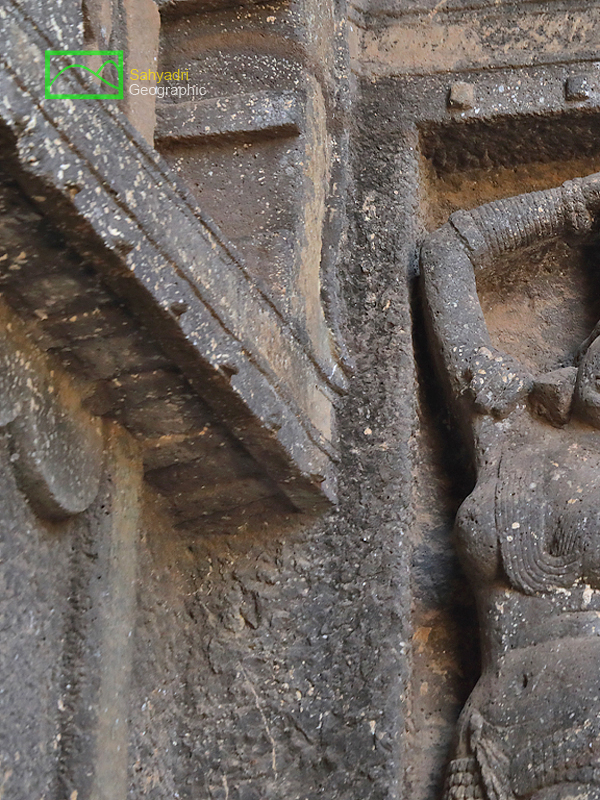  |
| |
| 26. Mithuna sculptures, Chaityagriha verandah, Karle Caves, Maval Tehsil, Pune district, Maharashtra, India |
| |
|
|
लेण्यात असलेल्या विविध स्त्री पुरुष मिथुन शिल्पातले एक शिल्प चैत्यगृहाच्या दालनात डाव्या बाजुला बाहेरच्या भिंतीवर, आतल्या बाजुला आहे. समृद्धी आणि सर्वसामान्य जनमानसाचे प्रतीक म्हणून कोरलेली अशी शिल्प भारतातल्या विविध लेण्यात, मंदिरात आढळतात. या परंपरेप्रमाणे कार्ले आणि इतर बौद्ध लेण्यात सुद्धा अशी स्त्री पुरुष मिथुन शिल्प कोरली आहेत. चैत्यगृहाच्या आत खांबांवर आणि बाहेरच्या दालनात भिंतींवर दर्शनी भागात अशी शिल्प आहेत. या शिल्पात स्त्री ने तिच्या केसात काही फुलांचा अलंकार खोचलेला दिसतो. तिच्या गळ्यात मण्यांचा हार, हातात मण्यांच्या बांगड्या, पायात मोठे वाळे, कपाळावर चंद्र टिका (दागिना) , कंबर पट्टा कोरला आहे. पुरुषांच्या हातात मणी असलेली आणि साधी कडी आहेत.
|
|
The theme of Mithuna was widely popular and also cherished by the Indian artist as a motif of common fascination and auspicious bearing during the centuries before and after the Christian era. It was in fact considered a symbol of human plenty and prosperity, symbol of human society Mithuna of man and woman as a motif to represent the human society in general. The beginning of Mithuna on the temple entrance may be traced back to the early practice of showing the Mithuna and Dampati figures particularly on facades of the rock-cut caves of the Deccan. Not only on the lower portions of the walls in the verandah the large panels on either side of the entrance portray standing Mithuna and Dampati couples, but there are also found on either side of the great sun-window arch or at the same level on side walls. In this sculpture woman is wearing some ornamentation in her hair, probably some flower decoration. She has beaded necklace, several beaded and ornamented wrist anklets, large bracelets in her legs, ornaments on her forehead (with moon symbol), waist ornamentation. The man has beaded and non beaded wrist bracelets.
|
|
|
| |
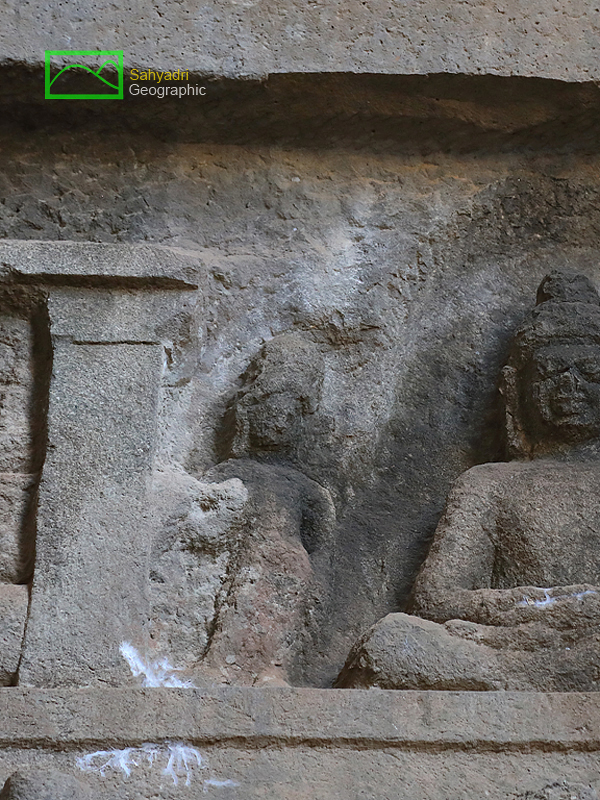 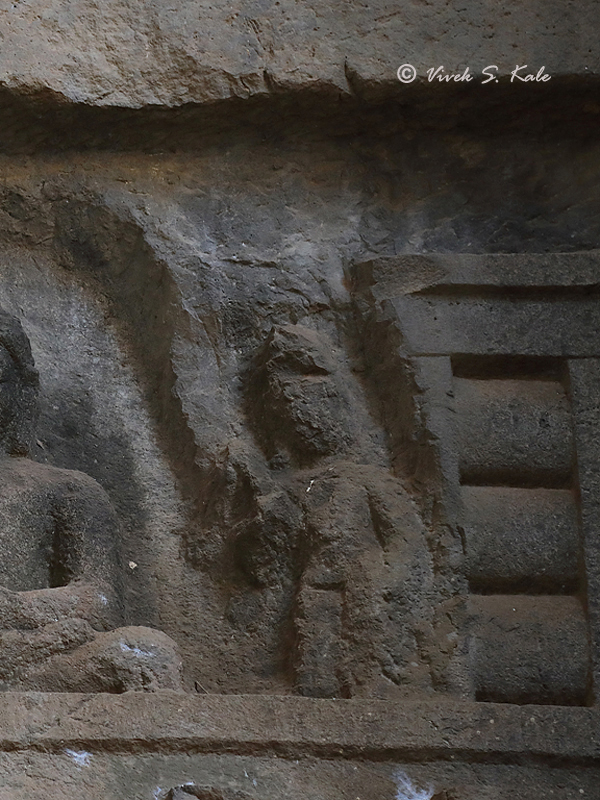 |
| |
| 27. Gautam Buddha sculpture, Chaityagriha verandah (Right side) side wall, Karle Caves, Maval Tehsil, Pune district, Maharashtra, India |
| |
|
|
चैत्यगृहाच्या दालनात भगवान गौतम बुद्धांचे ध्यानस्थ मुद्रेत असलेले शिल्प आहे. भगवान गौतम बुद्धांच्या दोन बाजूस दोन उभे बोधिसत्व आहेत. धर्म आणि संघ याबद्दल ध्यान, एकाग्रता याचे प्रतीक म्हणजे ध्यानमुद्रा होय. तळवा वर केलेले, एकेमेकांवर ठेवलेले दोन हात मांडीवर वर ठेवले आहेत. उजवा हात डाव्या हातावर ठेवला आहे. हे शिल्प महायान काळात कोरले आहे.
|
|
The verandah of chaityagriha has a sculpture of seating haloed Buddha in meditation mudra or dhnyan mudra. Buddha is flanked with standing Bodhisatvas on either side. Dhnyanmudra signifies meditation, concentration of the good Law and the saṅgha. The two hands are placed on the lap, right hand on left with fingers fully stretched (four fingers resting on each other and the thumbs facing upwards towards one another), with palms facing upwards. This panel is Mahayana Buddhism sculpture made in Mahayana period.
|
|
|
| |
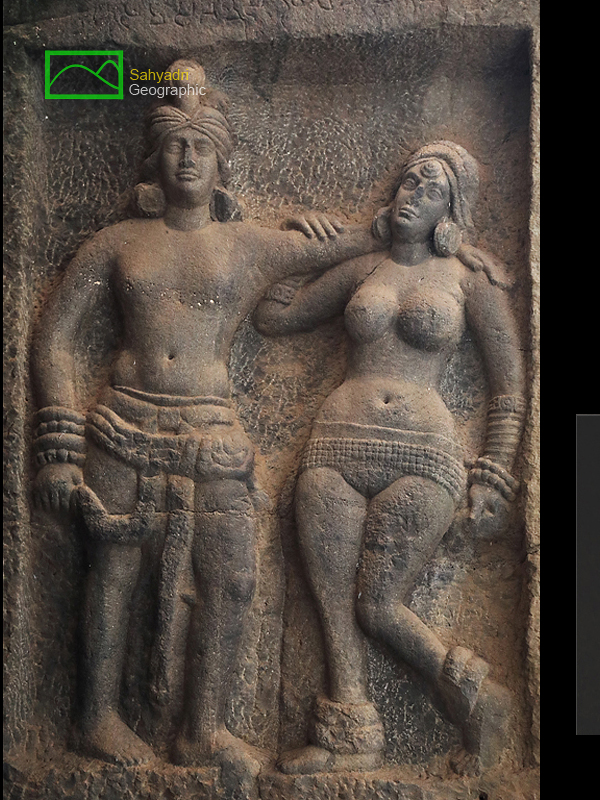 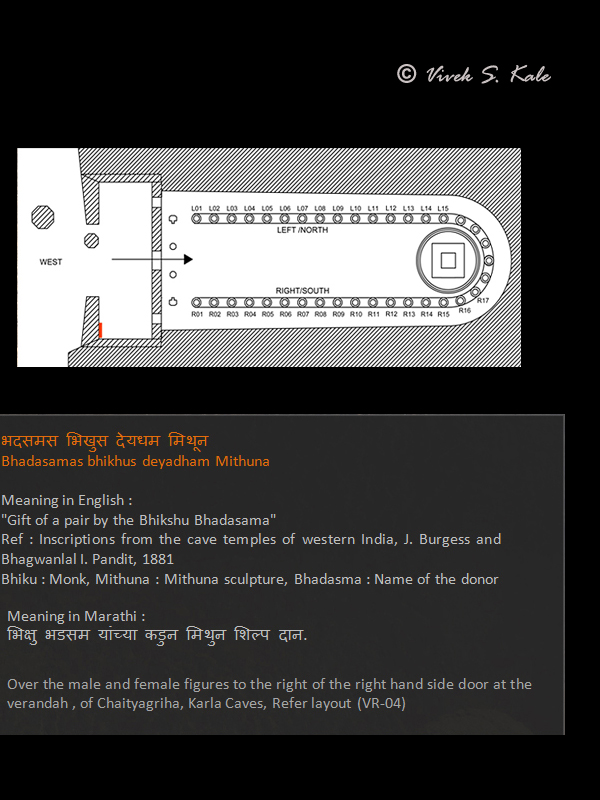 |
| |
| 28. Mithuna Sculptures, Chaityagriha verandah (Right side) side wall ornamentation, Karle Caves, Maval Tehsil, Pune district, Maharashtra, India |
| |
|
|
लेण्यात असलेल्या विविध स्त्री पुरुष मिथुन शिल्पातले एक शिल्प चैत्यगृहाच्या दालनात डाव्या बाजुला बाहेरच्या भिंतीवर, आतल्या बाजुला आहे. समृद्धी आणि सर्वसामान्य जनमानसाचे प्रतीक म्हणून कोरले अशी शिल्प भारतातल्या विविध लेण्यात, मंदिरात आढळतात. या परंपरेप्रमाणे कार्ले आणि इतर बौद्ध लेण्यात सुद्धा अशी स्त्री पुरुष मिथुन शिल्प कोरली आहेत. चैत्यगृहाच्या आत खांबांवर आणि बाहेरच्या दालनात भिंतींवर दर्शनी भागात अशी शिल्प आहेत. या शिल्पात स्त्रीच्या हातात बांगड्या, मण्यांच्या माळा, पायात मोठे वाळे, कर्णभुषण, कपाळावर टिका (दागिना) , कोरले आहेत. पुरुषांच्या हातात मण्यांच्या माळा आणि साधी कडी आहेत.
येथे मिथुन शिल्पाच्या वर एक ब्राह्मी लिपीत कोरलेला शिलालेख आहे.
भदसमस भिखुस देयधम मिथून
या शिलालेखाचा मराठीत अर्थ :
भिक्षु भडसम यांच्या कडुन मिथुन शिल्प दान.
|
|
The theme of Mithuna was widely popular and also cherished by the Indian artist as a motif of common fascination and auspicious bearing during the centuries before and after the Christian era. It was in fact considered a symbol of human plenty and prosperity, symbol of human society Mithuna of man and woman as a motif to represent the human society in general. The beginning of Mithuna on the temple entrance may be traced back to the early practice of showing the Mithuna and Dampati figures particularly on facades of the rock-cut caves of the Deccan. Not only on the lower portions of the walls in the verandah the large panels on either side of the entrance portray standing Mithuna and Dampati couples, but there are also found on either side of the great sun-window arch or at the same level on side walls. Woman has several beaded and ornamented wrist anklets, large bracelets in her legs, ornaments on her forehead, waist ornamentation and earrings. The man has beaded and non beaded wrist bracelets.
There is an inscription at this location above the Mithuna sculptures.
भदसमस भिखुस देयधम मिथून
Bhadasamas bhikhus deyadham Mithuna
Meaning in English :
"Gift of a pair by the Bhikshu Bhadasama"
|
|
|
| |
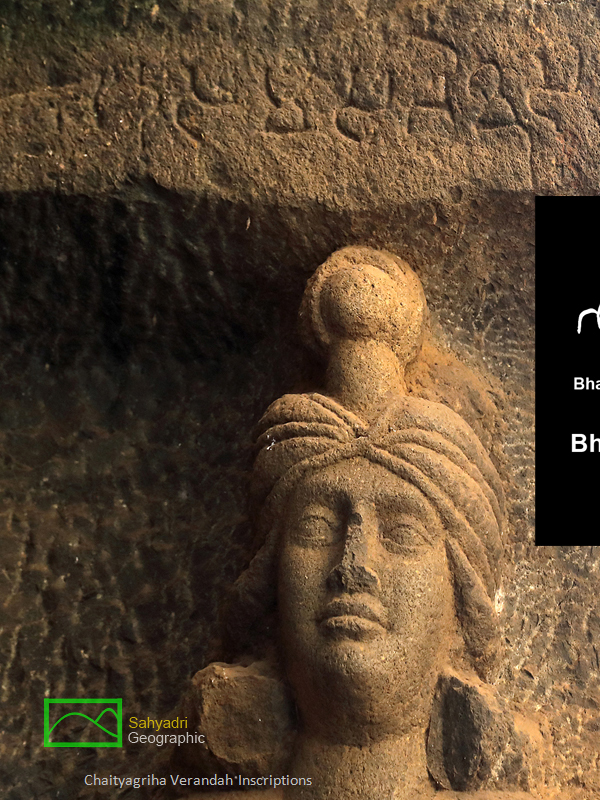 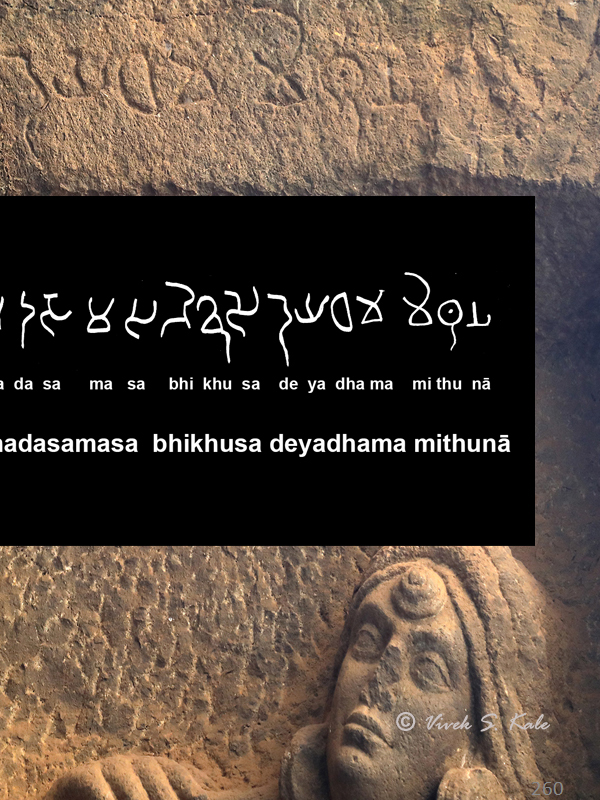 |
| |
| 29. Inscription at Mithuna Sculpture, Chaityagriha verandah (Right side) side wall ornamentation, Karle Caves, Maval Tehsil, Pune district, Maharashtra, India |
| |
|
|
| |
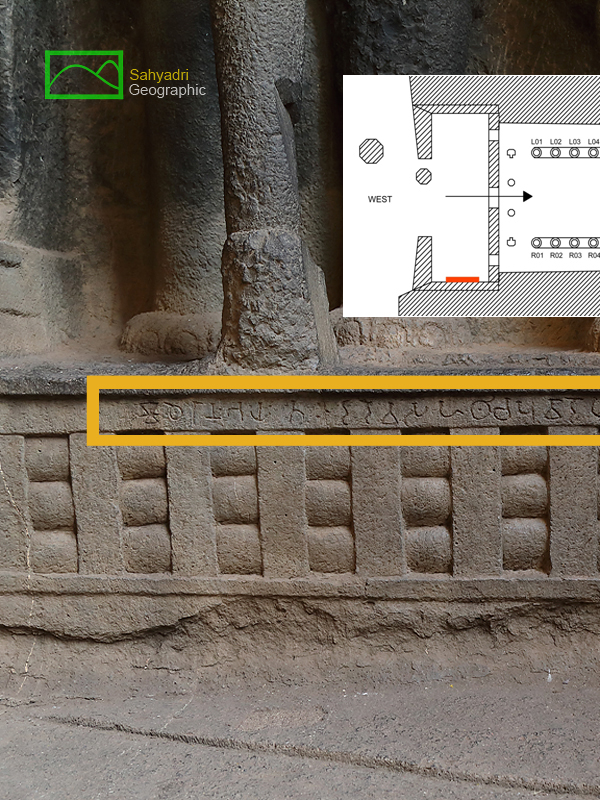  |
| |
| 30. Inscription in Chaityagriha verandah (Right side) side wall, Karle Caves, Maval Tehsil, Pune district, Maharashtra, India |
| |
|
|
| |
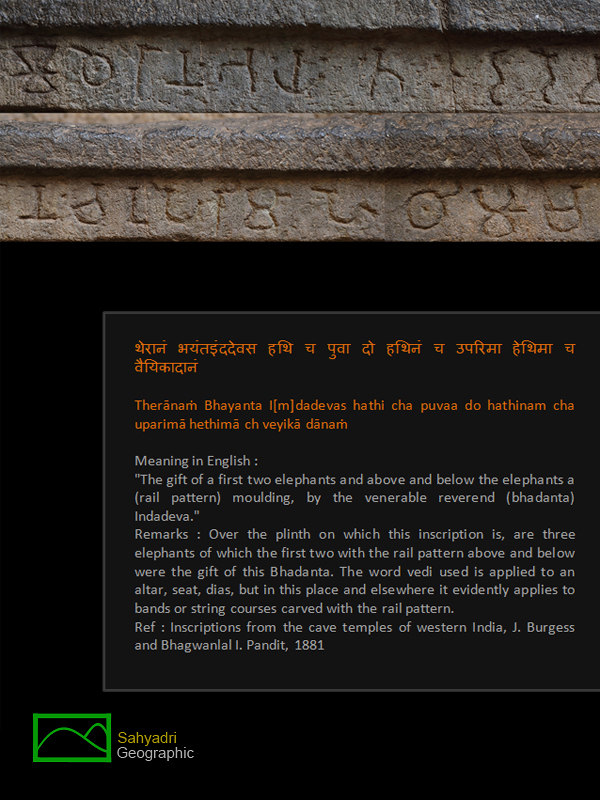 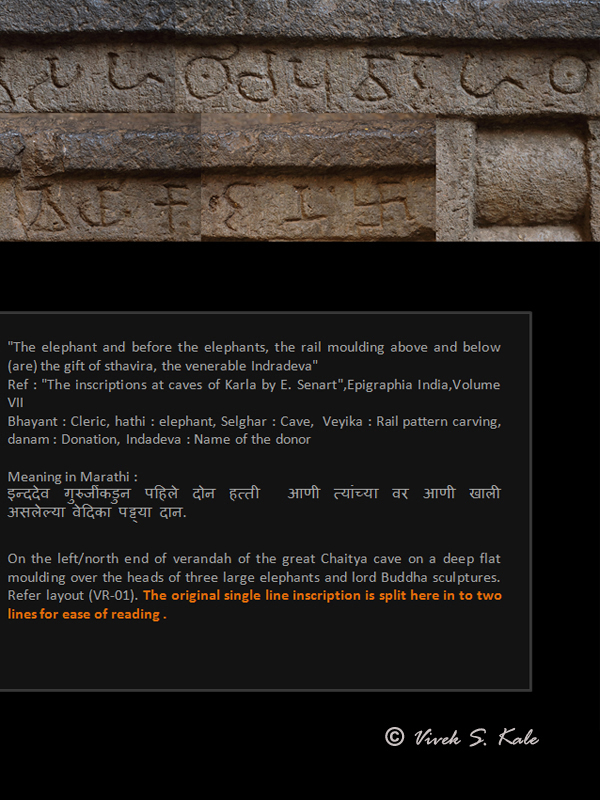 |
| |
| 31. Inscription in Chaityagriha verandah (Right side) side wall, Karle Caves, Maval Tehsil, Pune district, Maharashtra, India |
| |
|
|
| |
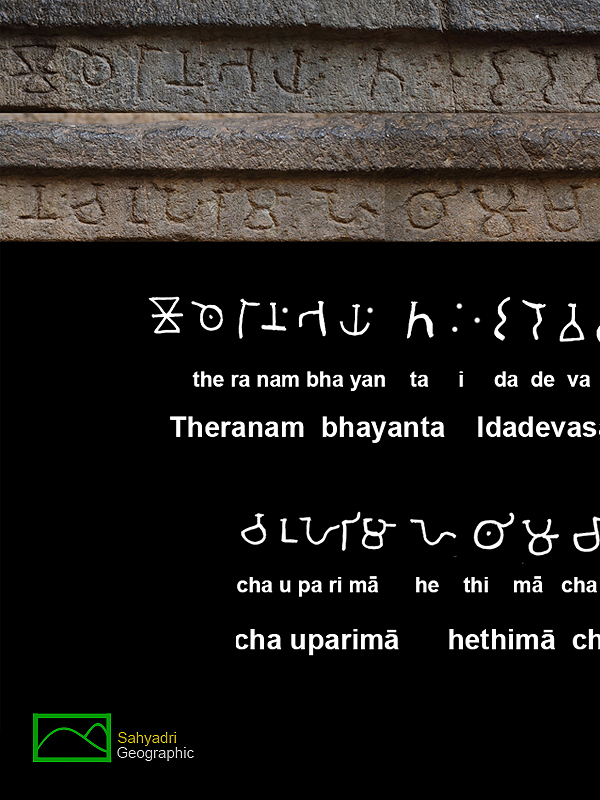 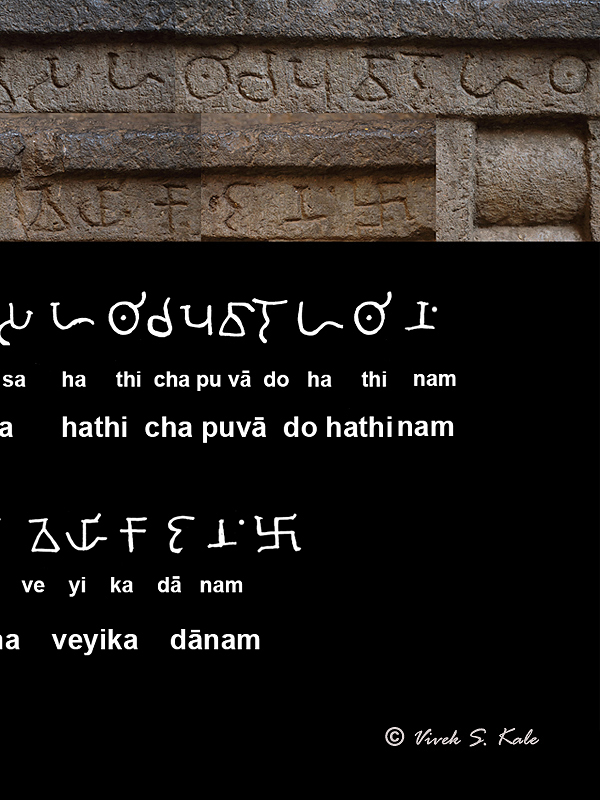 |
| |
| 32. Inscription in Chaityagriha verandah (Right side) side wall, Karle Caves, Maval Tehsil, Pune district, Maharashtra, India |
| |
|
|
| |
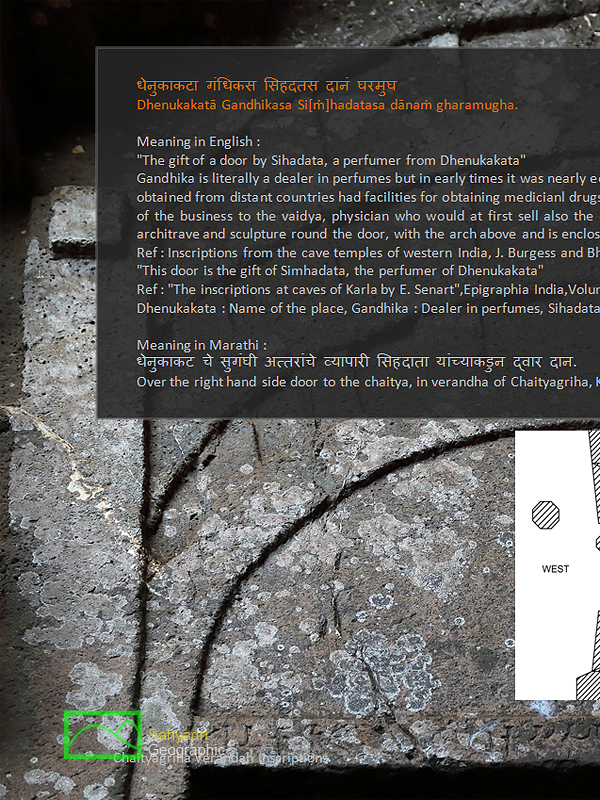 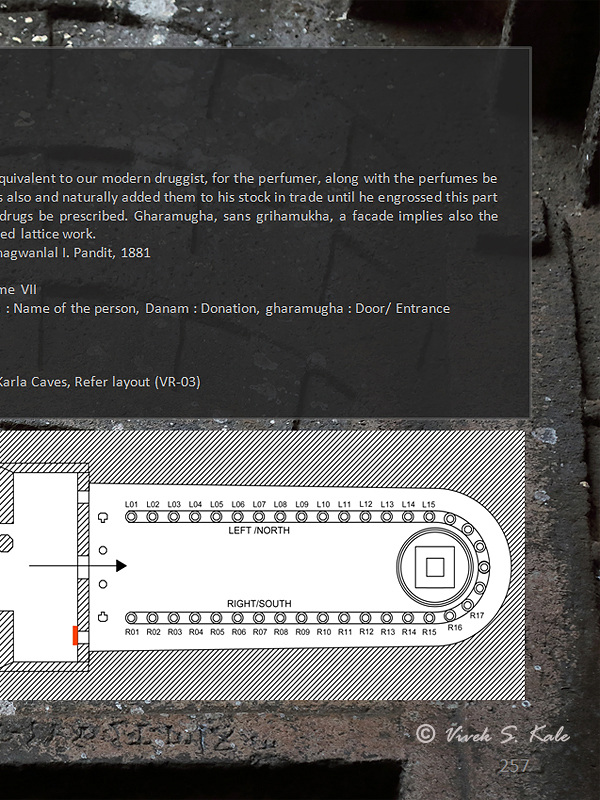 |
| |
| 33. Inscription in Chaityagriha verandah (Right side) above the side door of chaityagriha, Karle Caves, Maval Tehsil, Pune district, Maharashtra, India |
| |
|
|
| |
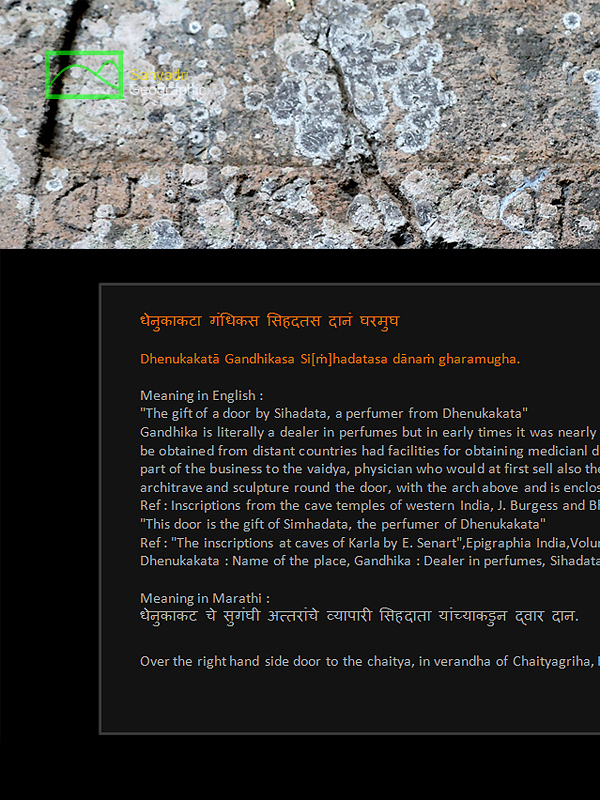  |
| |
| 34. Inscription in Chaityagriha verandah (Right side) above the side door of chaityagriha, Karle Caves, Maval Tehsil, Pune district, Maharashtra, India |
| |
|
|
| |
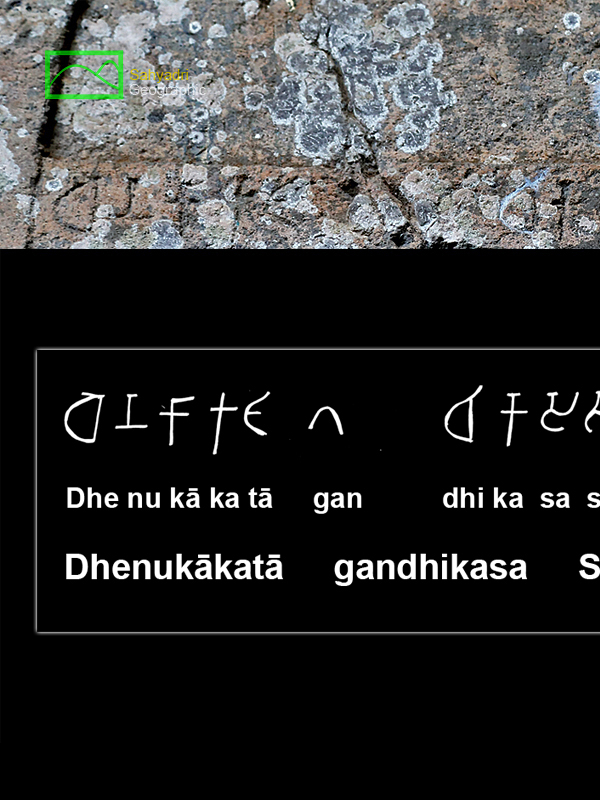  |
| |
| 35. Inscription in Chaityagriha verandah (Right side) above the side door of chaityagriha, Karle Caves, Maval Tehsil, Pune district, Maharashtra, India |
| |
|
|
| |
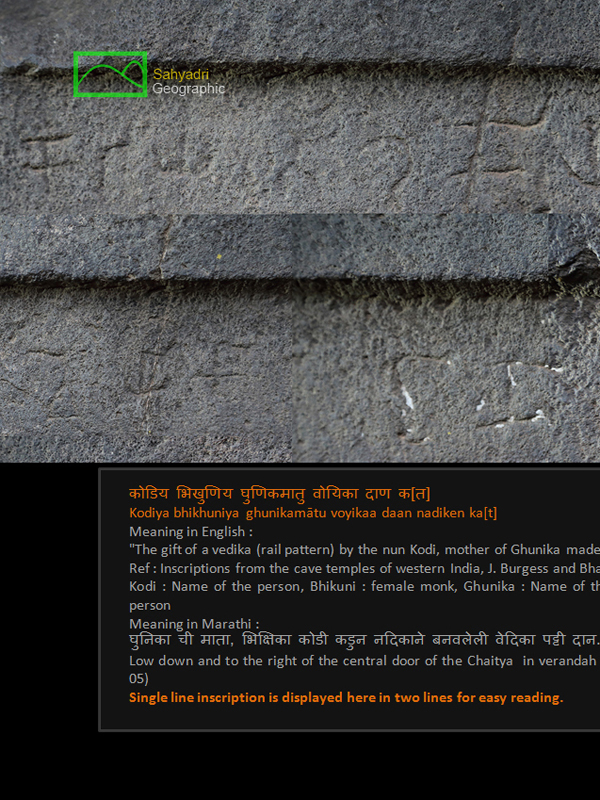  |
| |
| 36. Inscription Chaityagriha verandah, Karle Caves, Maval Tehsil, Pune district, Maharashtra, India |
| |
|
|
| |
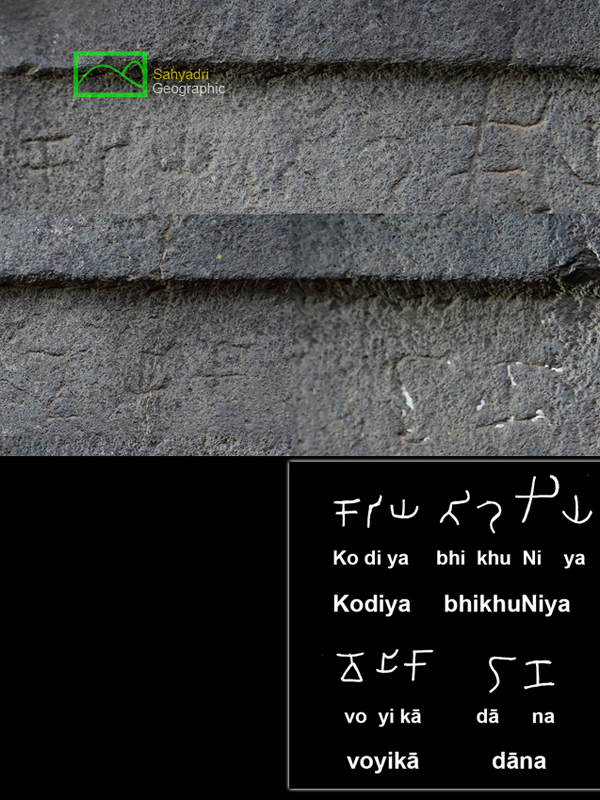  |
| |
| 37. Inscription Chaityagriha verandah, Karle Caves, Maval Tehsil, Pune district, Maharashtra, India |
| |
|
|
| |
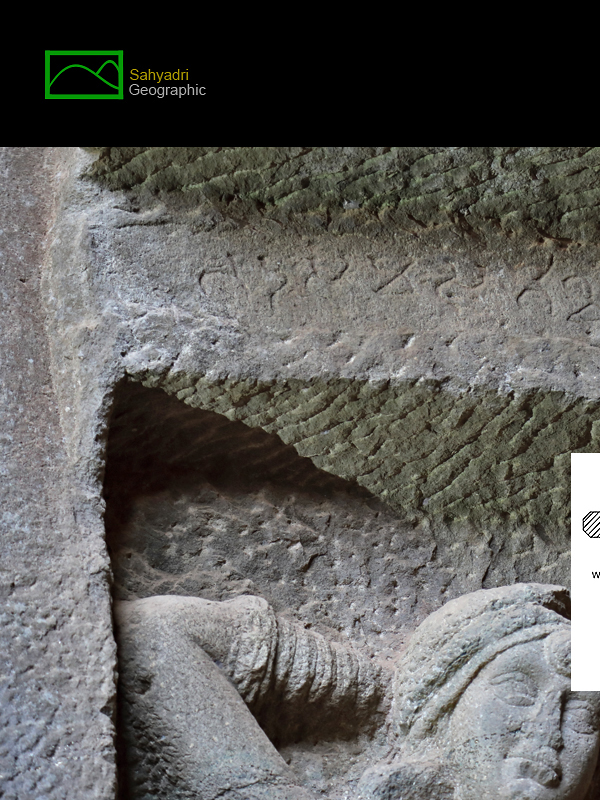  |
| |
| 38. Inscription Chaityagriha verandah, Karle Caves, Maval Tehsil, Pune district, Maharashtra, India |
| |
|
|
| |
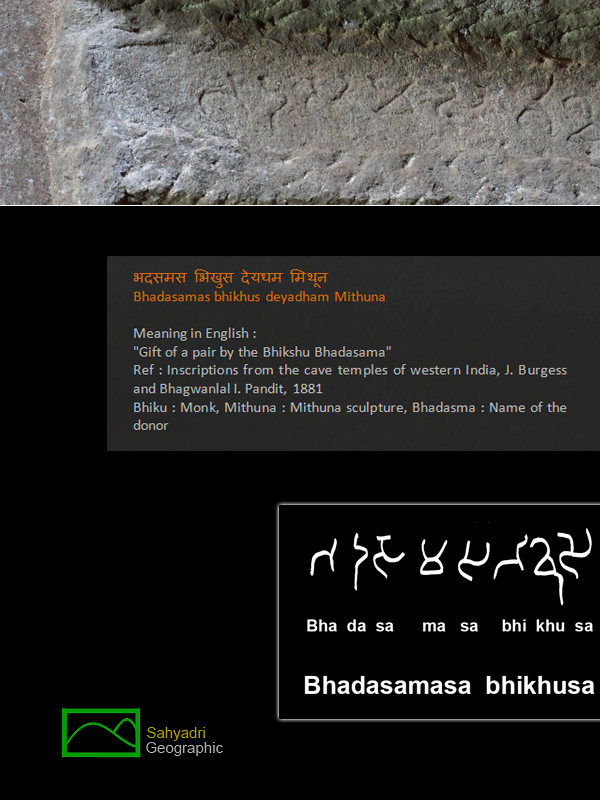 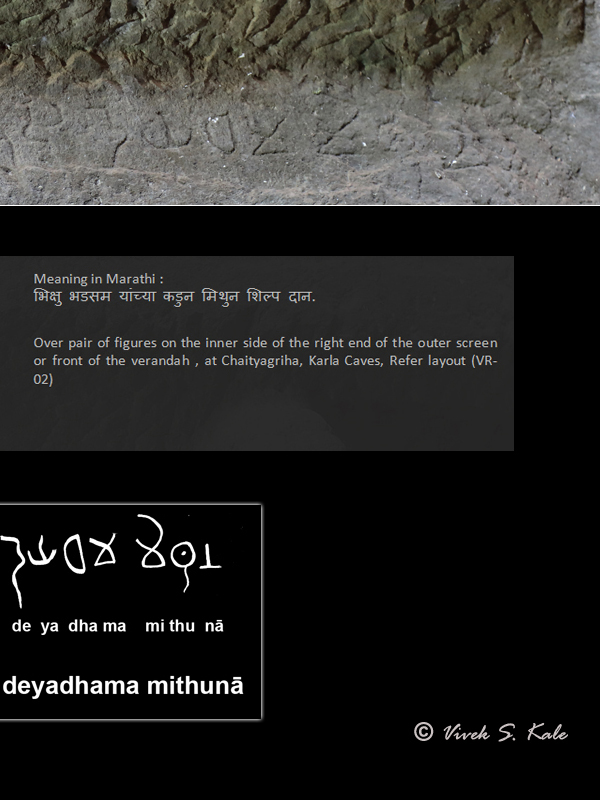 |
| |
| 39. Inscription Chaityagriha verandah, Karle Caves, Maval Tehsil, Pune district, Maharashtra, India |
| |
|
|
| |
  |
| |
| 40. Important Ksahtrapa Inscription Chaityagriha verandah, Karle Caves, Maval Tehsil, Pune district, Maharashtra, India |
| |
|
|
| |
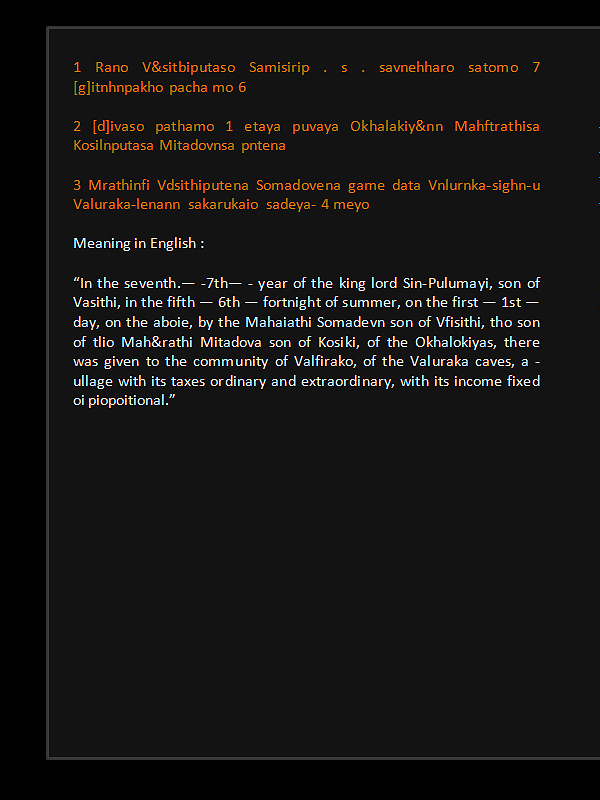 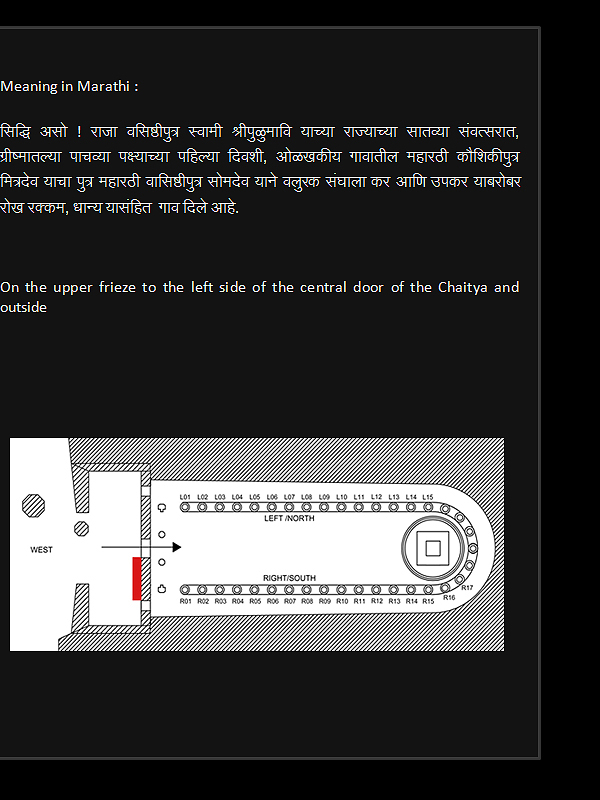 |
| |
| 41. Important Satvahana Inscription Chaityagriha verandah, Karle Caves, Maval Tehsil, Pune district, Maharashtra, India |
| |
|
|
| |
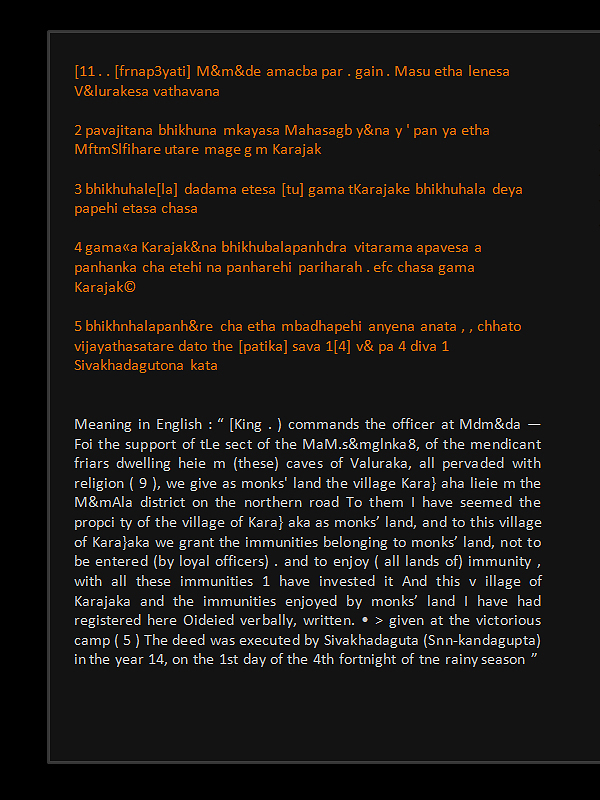 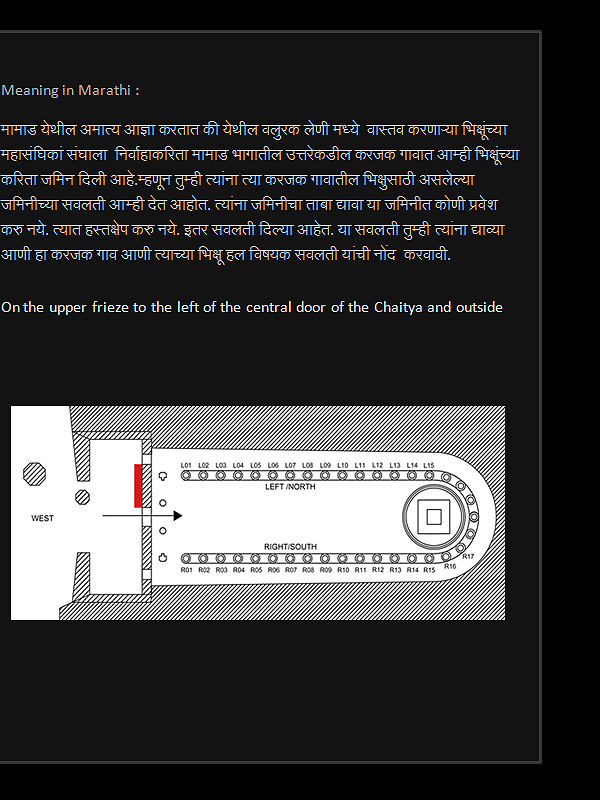 |
| |
| 42. Important Inscription Chaityagriha verandah, Karle Caves, Maval Tehsil, Pune district, Maharashtra, India |
| |
|
|
| |
 |
| |
|
|
References :
1. Cave temples of India, London, 1880, Fergusson James and Burgess James.
2. Gazetters of Bombay Presidency, Poona District, Volume XVIII, 1885.
3. Buddhist architecture of western India, 1981, S. Nagraju.
4. Burgess James and Inderaji Pandit Bhagavanlal, Inscriptions from the cave temples of western India, ASWI X, London, 1881.
|
| |
|
|
| |
|

























































































